|
|
Gurnee, Illinois
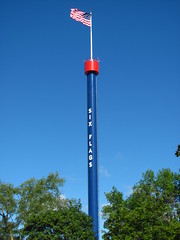 I was once asked by a friend why Cedar Point was able to build better rides than Six Flags Great America. It caused me a moment’s pause. Great America doesn’t have much in the way of truly bad rides, and I’d say the worst roller coasters near Chicago are significantly better than the worst roller coasters near Sandusky. It’s just that the pleasures are smaller in scale, which should be no less important. Demon, Viper, American Eagle, Whizzer, and others are all coasters whose merits, though minor, are very real. I was once asked by a friend why Cedar Point was able to build better rides than Six Flags Great America. It caused me a moment’s pause. Great America doesn’t have much in the way of truly bad rides, and I’d say the worst roller coasters near Chicago are significantly better than the worst roller coasters near Sandusky. It’s just that the pleasures are smaller in scale, which should be no less important. Demon, Viper, American Eagle, Whizzer, and others are all coasters whose merits, though minor, are very real.
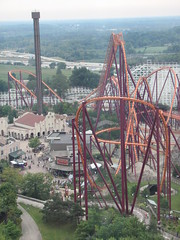 At that moment, however, the best defense of Great America I could think of was that they tend to be more experimentally-minded and buy more prototype technologies than their competitors or other parks in the Six Flags chain do. They have a strong relationship with Bolliger and Mabillard, I think through Bob Mampe, who worked here before going on to become one At that moment, however, the best defense of Great America I could think of was that they tend to be more experimentally-minded and buy more prototype technologies than their competitors or other parks in the Six Flags chain do. They have a strong relationship with Bolliger and Mabillard, I think through Bob Mampe, who worked here before going on to become one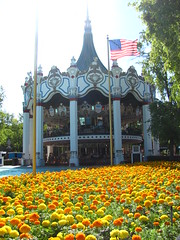 of the Swiss company’s main right-hand men. As a result Great America bought the first stand up coaster from B&M, the world’s first inverted coaster, one of the first B&M speed coasters, and they were also very early adopters of both the flying coaster technology and now the wing coaster technology. of the Swiss company’s main right-hand men. As a result Great America bought the first stand up coaster from B&M, the world’s first inverted coaster, one of the first B&M speed coasters, and they were also very early adopters of both the flying coaster technology and now the wing coaster technology.
The major problem with this strategy of leading the technological curve is that after a couple of years what was once innovative will look humble, and a newer model will debut somewhere in the world that realizes more of the hidden potential of the technology that prototypes are infrequently able to tap. Cedar Point uses the opposite strategy as Great America, waiting until new technologies have matured at other parks before they order it for themselves. Armed with bigger, faster, and usually better coasters that are more difficult for competitors to expand upon in terms of scale or quality, their collection is therefore able to stand the test of time and dominate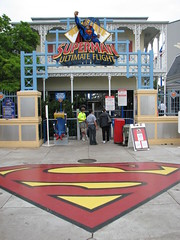 the top ten lists over the long term. The irony is, parks like Cedar Point need parks like Great America to exist. Otherwise we’d never get anything original or good. Batman: The Ride is the perfect example of this: a terrific roller coaster in its own right, Raptor expands on the qualities that made Batman good and roughly two decades later Raptor is still making the front page of the Golden Ticket Awards list while Batman (perhaps with fans scattered between its many iterants) is nowhere to be found. the top ten lists over the long term. The irony is, parks like Cedar Point need parks like Great America to exist. Otherwise we’d never get anything original or good. Batman: The Ride is the perfect example of this: a terrific roller coaster in its own right, Raptor expands on the qualities that made Batman good and roughly two decades later Raptor is still making the front page of the Golden Ticket Awards list while Batman (perhaps with fans scattered between its many iterants) is nowhere to be found.
At least the park’s other inverted superhero themed coaster, Superman: Ultimate Flight has no direct equivalent at Cedar Point. It in many ways recalls its predecessor while in other ways offering the completely opposite experience. Batman is gritty and intense and based on quick variations in the layout, while Superman is graceful and slower paced, based on creating a singular flight sensation, and quite honestly it’s all a tad boring. It’s probably no surprise then that most enthusiasts (myself included) would take Batman over Superman any day of the week.
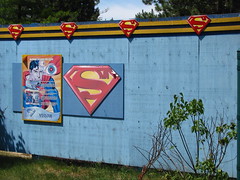 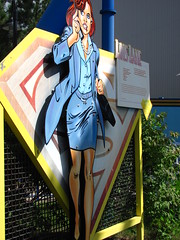 That said there is more to justify the “Superman Experience” than I originally would have admitted, but what’s there still isn’t nearly enough to justify any two-hour waits. I speak from experience, as the longest I ever waited for a roller coaster was this ride back in 2005 at nearly three and a half hours (there might have been longer lines in Millennium Force’s opening year but I can’t recall the specifics). The queue is one of the most dreadful in the park, a poor combination of slow dispatch times, high popularity with the public, and a configuration that first keeps you pent up in a claustrophobic cattle pen before sun baking you in a shadeless beeline to the station with faded informational comic posters That said there is more to justify the “Superman Experience” than I originally would have admitted, but what’s there still isn’t nearly enough to justify any two-hour waits. I speak from experience, as the longest I ever waited for a roller coaster was this ride back in 2005 at nearly three and a half hours (there might have been longer lines in Millennium Force’s opening year but I can’t recall the specifics). The queue is one of the most dreadful in the park, a poor combination of slow dispatch times, high popularity with the public, and a configuration that first keeps you pent up in a claustrophobic cattle pen before sun baking you in a shadeless beeline to the station with faded informational comic posters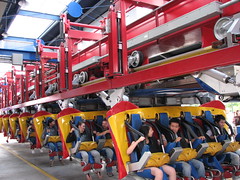 to keep our eyes off the many empty pairs of seats between riders that are often seen cycling overhead. Flash Pass is recommended if you’re serious about riding Superman even once on even a moderately busy day. to keep our eyes off the many empty pairs of seats between riders that are often seen cycling overhead. Flash Pass is recommended if you’re serious about riding Superman even once on even a moderately busy day.
The prone “flying” position does transform the ride experience into something relatively different from the rest. Pretty much every g-force you feel is redirected by 90 degrees, creating new directional forces we rarely if ever get to feel on a coaster, e.g. forward and backward forces are normally only felt on launches and brake runs; maybe spinning coasters. And in none of those situations are the g-forces derived from gravitational conflicts (along the up-down axis), giving a unique vocabulary to the styles of sensations on this coaster.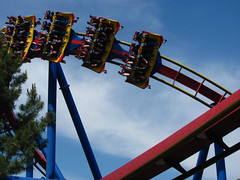
On the other hand I’m still not convinced that this seating position is the best way to achieve a flying sensation on a roller coaster. The main reason is that when we imagine what it would feel like to free-fly, a sense of freedom (which I think latently implies a form of zero-gravity) is generally assumed. That’s obviously not possible to sustain, and the constant downward pull on our bodies in a rather awkward position psychologically keeps us fairly earthbound; and that’s yet not including the somewhat encumbering, bear-hug restraints in the equation. Actually they are quite comfortable (compared to the Vekoma Flying Dutchmen) but the fact remains that resting on your chest is a kind of unnatural feeling position, and that’s something a true flying coaster can’t be without.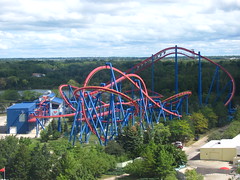
Then there’s the layout. Maybe it’s just me but if I could fly like Superman I wouldn’t zig-zag over the same cleared field. I’d go places, over and under things, stuff like that. Every seat has an unrestricted view, and yet the park doesn’t capitalize on this at all; the uniform mowed lawn it’s built on only broken up by the same blue supports and the occasional queue line (where everyone underneath quietly wonders if we’ll spit or drop change on them as we pass overhead).
Also, in terms of layout progression, it’s rather awkward. The initial pretzel loop easily stands alone as a completely unique defining moment of the ride. The dynamics are unlike anything else, so when it comes right at the beginning of the layout it makes the rest of the coaster feel boring by contrast. Airtime at the top, strong positives at the bottom, plus the rapidly changing orientation to the ground that has us in a kamikaze dive upside down. And remember these are all skewed by 90 degrees so it’s a particularly wacky brand of airtime that presses up on your chest instead of from underneath, and the force at the bottom feels like it’s going to push your stomach out of your esophagus. It’s a cool element, possibly the most impressive single maneuver inside Great America’s gates. so when it comes right at the beginning of the layout it makes the rest of the coaster feel boring by contrast. Airtime at the top, strong positives at the bottom, plus the rapidly changing orientation to the ground that has us in a kamikaze dive upside down. And remember these are all skewed by 90 degrees so it’s a particularly wacky brand of airtime that presses up on your chest instead of from underneath, and the force at the bottom feels like it’s going to push your stomach out of your esophagus. It’s a cool element, possibly the most impressive single maneuver inside Great America’s gates.
 After that, layout, elements, pacing and progression all get shoved out the door in favor After that, layout, elements, pacing and progression all get shoved out the door in favor of a somewhat idyllic series of turns that don’t accomplish anything other than give a unified sensation of flying for several seconds. From a designer’s perspective, this track is pretty simple; looking at it from the station I realized most of the curves were based on simple geometric shapes and parabolic contours, nothing more advanced or intricate, with very long transitions. This section of the ride is rather short as well, of a somewhat idyllic series of turns that don’t accomplish anything other than give a unified sensation of flying for several seconds. From a designer’s perspective, this track is pretty simple; looking at it from the station I realized most of the curves were based on simple geometric shapes and parabolic contours, nothing more advanced or intricate, with very long transitions. This section of the ride is rather short as well,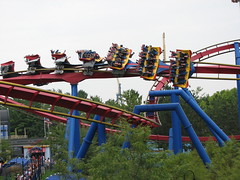 only about 22 seconds before the free-flight only about 22 seconds before the free-flight is over and we’re wrapping it up with the final inline roll into the brakes. is over and we’re wrapping it up with the final inline roll into the brakes.
By the way, here’s an interesting debate I’m not sure I’ve ever seen had: does this final roll count as an inversion? By most accounts, yes, the track clearly rotates a complete 360 degrees. But what about from the rider’s perspective? It simply rotates you sideways from laying on your stomach to laying your back, so it doesn’t seem proper to call it anything that implies we’ll be inverted. Yet it also would seem wrong to not call it an inversion, when the track is shaped nearly identical to other heartline rolls and in-line twists on standard, upright coasters, so why should those elemental properties change just when a particular train design is on them instead? Food for thought…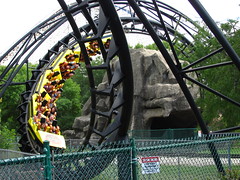
If all of Six Flags Great America’s coasters went to high school, Demon would be the sweetly shrimpy nerd that dyed his hair jet black and got an ear piercing to try to fit in with the hipster goths. It’s got the all-black paint scheme with goofy rock-face structures, two special effects tunnels that try to dazzle and impress even though they used these big, carnival style incandescent light bulb strips, and of course the old “Demon Song” was playing all over the station. Step into the Demon queue and you’ll be directly transported back into 1980.
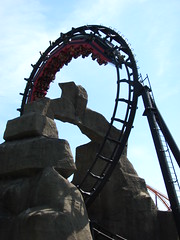 The coaster itself is pretty decent, particularly enhanced The coaster itself is pretty decent, particularly enhanced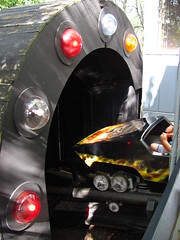 at night when the line tends to be its shortest. You do have to be of a certain height to enjoy these Arrow looping coasters, as too short can mean the horsecollar restraints connect with your earlobes, and too tall means they fit uncomfortably tight on top of your shoulders. If you’re in the intended height range then the first drop and two loops can be a fun, intense and dizzying affair. I’m curious what it was like as the Turn of the Century and had two camelback hills where the loops are today; they looked like more extreme versions of Cedar Point’s Corkscrew’s single air hill and that one is quite intense by itself. at night when the line tends to be its shortest. You do have to be of a certain height to enjoy these Arrow looping coasters, as too short can mean the horsecollar restraints connect with your earlobes, and too tall means they fit uncomfortably tight on top of your shoulders. If you’re in the intended height range then the first drop and two loops can be a fun, intense and dizzying affair. I’m curious what it was like as the Turn of the Century and had two camelback hills where the loops are today; they looked like more extreme versions of Cedar Point’s Corkscrew’s single air hill and that one is quite intense by itself.
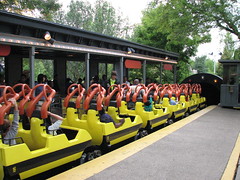 Things like the long straightaway in the special effects tunnel or diving through the mouth of a rock face cave help make the coaster an exciting one, campy though these touches are. The second half after the tunnel doesn’t have quite as much going for it as the first; the turnaround takes a while to get through and then the corkscrews over the railroad tracks and final helix are both a bit slower paced and a bit rougher (the transition from the drop into the first corkscrew in particular has a bad kink in it you’ll want to brace for). But it helps round out the layout to feel more complete than some of the other early small scale Arrow multiloopers that barge through the course in less than 45 seconds. Honestly I don’t miss the much larger Shockwave at all since Great America Things like the long straightaway in the special effects tunnel or diving through the mouth of a rock face cave help make the coaster an exciting one, campy though these touches are. The second half after the tunnel doesn’t have quite as much going for it as the first; the turnaround takes a while to get through and then the corkscrews over the railroad tracks and final helix are both a bit slower paced and a bit rougher (the transition from the drop into the first corkscrew in particular has a bad kink in it you’ll want to brace for). But it helps round out the layout to feel more complete than some of the other early small scale Arrow multiloopers that barge through the course in less than 45 seconds. Honestly I don’t miss the much larger Shockwave at all since Great America still has the Demon, whose mixture of low-key thrills with a larger-than-life persona and 1980’s cheese fest, make it one of the most purely fun coasters in Six Flags Great America. still has the Demon, whose mixture of low-key thrills with a larger-than-life persona and 1980’s cheese fest, make it one of the most purely fun coasters in Six Flags Great America.
Similar has been said about the relative entertainment value to its unpretentious scale for the Viper, but I must admit more mixed feelings for this attraction. Many regard it as the best pre-millennial wooden coaster operating at a Six Flags amusement park, mostly for its pops of airtime combined with a very comfortable, well maintained ride. I don’t contest either of these points as it’s been a number of years since Viper has felt anything less than brand new, but as another Cyclone-clone the layout seems relatively conservative and doesn’t do much for me.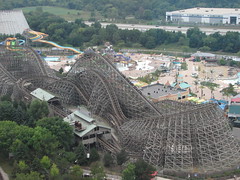
It’s still a very fun ride, and easily accessible to people unsure about wooden coasters. The station and setting is great, the cathedral-like support structure looks magnificent, the two thirty-passenger trains keep the line moving, and best of all it is impeccably maintained. It feels like luxury shock absorbers have been retrofitted to the trains, so smooth do we sail over airtime hills and turns with no loss of pace due to potholing or shuffling that normally plagues wooden coasters from this era. I couldn’t be sure but it appeared as though there were more layers of wood that make up the track than on most wooden coasters.
So why do I merely give it a passing grade?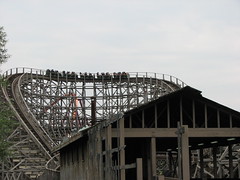 I think it was just that the coaster lacked much bite. Many of the bookending fan turns were a bit of a snooze, the first one with very gentle lead-ins/outs from the hill crests, and while the others have some lateral force to them the transitions feel similarly controlled. There was none of the sharp snaps around corners and into drops that I enjoyed on the Georgia Cyclone. Things are better when moving along a mostly straight path over camelbacks or bunny hops, but again in all seats they lacked any sort of aggressiveness, instead opting for smooth, sustained floater air. That’s alright in most cases, but not for a ride based on the Cyclone where I expect more out-of-control intensity. Regardless, this isn’t the ideal layout for that type of airtime since only one or two hills are achieved before the pace has to halt for another fan turn that accomplishes little besides I think it was just that the coaster lacked much bite. Many of the bookending fan turns were a bit of a snooze, the first one with very gentle lead-ins/outs from the hill crests, and while the others have some lateral force to them the transitions feel similarly controlled. There was none of the sharp snaps around corners and into drops that I enjoyed on the Georgia Cyclone. Things are better when moving along a mostly straight path over camelbacks or bunny hops, but again in all seats they lacked any sort of aggressiveness, instead opting for smooth, sustained floater air. That’s alright in most cases, but not for a ride based on the Cyclone where I expect more out-of-control intensity. Regardless, this isn’t the ideal layout for that type of airtime since only one or two hills are achieved before the pace has to halt for another fan turn that accomplishes little besides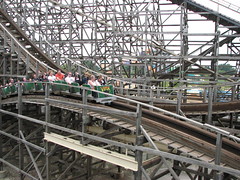 turning the train around again. Probably the most effective moment was the double dip off the second turn and the sharp, straight camelback hill buried in the lift super structure that followed. Intense, yes. Aggressive, not quite; the transitions were still feather-light and lacked the snap I’d expect from a true wooden twister. It’s not enough to just be held out of my seat, I want to be jolted out of it. Maybe it was just a case of having the wrong expectations, but I personally would take the other, edgier Cyclone counterparts over this one any day of the week. Viper is the caffeine-free substitute product for people who find the original too strong. turning the train around again. Probably the most effective moment was the double dip off the second turn and the sharp, straight camelback hill buried in the lift super structure that followed. Intense, yes. Aggressive, not quite; the transitions were still feather-light and lacked the snap I’d expect from a true wooden twister. It’s not enough to just be held out of my seat, I want to be jolted out of it. Maybe it was just a case of having the wrong expectations, but I personally would take the other, edgier Cyclone counterparts over this one any day of the week. Viper is the caffeine-free substitute product for people who find the original too strong.
Great America’s other wooden coaster, the American Eagle, was an attraction I used to never care for very much, or even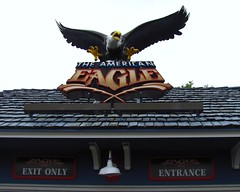 gave much thought to. Which genius was it that thought a gigantic helix in the middle of a twin-tracked coaster would be a good element to ensure evenly timed races? The plus-plus-sized heights and speeds only meant that a): the fast parts would be all the more rough and unbearable, and b): they would quickly be braked, turning it into one of those overscaled lame duck monstrosities. Being one of only two coasters in the park without Flash Pass entry is also not a good omen; the station is located behind the railroad tracks leading to an awkward, half-mile queue over and around obstacles that would be nearly impossible to integrate a Flash Pass merge point with, not that it matters since the dual dispatches and lower popularity mean it usually has some of the shortest lines in the park anyway. gave much thought to. Which genius was it that thought a gigantic helix in the middle of a twin-tracked coaster would be a good element to ensure evenly timed races? The plus-plus-sized heights and speeds only meant that a): the fast parts would be all the more rough and unbearable, and b): they would quickly be braked, turning it into one of those overscaled lame duck monstrosities. Being one of only two coasters in the park without Flash Pass entry is also not a good omen; the station is located behind the railroad tracks leading to an awkward, half-mile queue over and around obstacles that would be nearly impossible to integrate a Flash Pass merge point with, not that it matters since the dual dispatches and lower popularity mean it usually has some of the shortest lines in the park anyway.
We’re poised on the edge of the first drop (147 ft, second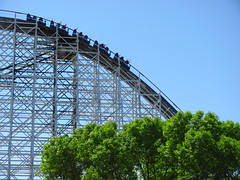 largest drop in the park and still well within the top ten for wooden coasters) and here’s a good sight to behold: no trim brakes anywhere along the first stretch of the ride! (Evidently I’ve been conditioned by Mean Streak to just assume they will be a prominent feature on any coaster that predates CCI’s first work.) The train falls way down, partially into a valley, the return tracks flanking either side of us and creating a cool support bridge overhead as we pull out of the first drop. largest drop in the park and still well within the top ten for wooden coasters) and here’s a good sight to behold: no trim brakes anywhere along the first stretch of the ride! (Evidently I’ve been conditioned by Mean Streak to just assume they will be a prominent feature on any coaster that predates CCI’s first work.) The train falls way down, partially into a valley, the return tracks flanking either side of us and creating a cool support bridge overhead as we pull out of the first drop.
The official statistic for speed is 66 mph. Normally I take those values with a grain of salt, at least for older coasters that probably haven’t run at their listed speed since opening season, but with no trim brakes or anything else holding us back, I must say,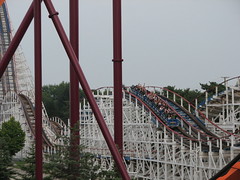 it felt fast. Almost dangerously fast. Despite the high speeds it wasn’t rough; those excellent Viper crews obviously have been spending a fair amount of time on the Eagle as well. However, there was a strong vibration, unlike anything else I’ve ever experienced: an extremely fine but aggressive vibration, like we’re sitting in a vibra-massage chair set on high. It doesn’t jostle us around, it just rattles our nerves while our center of gravity moves smoothly forward like we’re on Raging Bull. It also rattles my nerves thinking about how ridiculously fast we must be going to get this sort of sensation. it felt fast. Almost dangerously fast. Despite the high speeds it wasn’t rough; those excellent Viper crews obviously have been spending a fair amount of time on the Eagle as well. However, there was a strong vibration, unlike anything else I’ve ever experienced: an extremely fine but aggressive vibration, like we’re sitting in a vibra-massage chair set on high. It doesn’t jostle us around, it just rattles our nerves while our center of gravity moves smoothly forward like we’re on Raging Bull. It also rattles my nerves thinking about how ridiculously fast we must be going to get this sort of sensation.
Two very low bunny hops keep this incredible pace up as we get lifted over the crest of each hill for a couple moments of floater air. “Now this is what more roller coasters should be like,” I think as we rush through the final valley before the big pull-up, the terrifying speed melting the immediate surroundings into a blur as we charge along with the utmost control, feeling as though something could go wrong at any moment even though it hasn’t. A brake run is found at the top of this hill, not a big deal because we’re so far up that the train has slowed to 10 mph anyway. While the pacing has slowed to almost nil, the downward helix works very effectively at slowly building tension, as the speed continues to increase as we make our way around it, laterals increasing, vibrations getting stronger and stronger until we reach full speed in the last stretch. The slow building tension lets up for a fast, straight stretch of track as we cross under the upper layer of the helix, and then it implodes. A dip taking us the rest of the way to ground level comes I think as we rush through the final valley before the big pull-up, the terrifying speed melting the immediate surroundings into a blur as we charge along with the utmost control, feeling as though something could go wrong at any moment even though it hasn’t. A brake run is found at the top of this hill, not a big deal because we’re so far up that the train has slowed to 10 mph anyway. While the pacing has slowed to almost nil, the downward helix works very effectively at slowly building tension, as the speed continues to increase as we make our way around it, laterals increasing, vibrations getting stronger and stronger until we reach full speed in the last stretch. The slow building tension lets up for a fast, straight stretch of track as we cross under the upper layer of the helix, and then it implodes. A dip taking us the rest of the way to ground level comes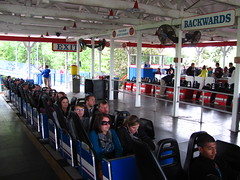 out of nowhere and hits us hard, especially riding in the back seat. Strong ejector air is sustained for a moment as the speed blasts back into the dangerous levels it was on the first leg of the journey. Some more lean, mean airtime hills follow showing off just how out of nowhere and hits us hard, especially riding in the back seat. Strong ejector air is sustained for a moment as the speed blasts back into the dangerous levels it was on the first leg of the journey. Some more lean, mean airtime hills follow showing off just how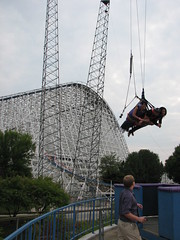 much power this coaster has when it’s running at full speed. It differs slightly depending on which side you’re on; the red side (left track going up the lift) is more intense with an extra airtime hill on the way back. much power this coaster has when it’s running at full speed. It differs slightly depending on which side you’re on; the red side (left track going up the lift) is more intense with an extra airtime hill on the way back.
The ride I described above could easily find its way onto my top 25 list of wooden coasters, but unfortunately those high-speed sections last too briefly, and on the return run we are halted after only two or three hills with a brake run that spits us into a pointless helix finale. Very slow by comparison to the rest of the ride, it’s also has the worst issues with shuffling, and in general breaks flow and feels like it belongs to a different ride. After that distraction we’re greeted with another brake run, this one final. Regardless, today I firmly consider the American Eagle one of my favorite roller coasters at Six Flags Great America, along with the next and last ride I’ll review.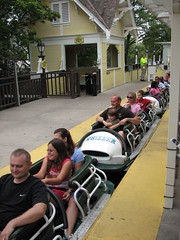
Is there no pride left in being a family coaster? These days if a park wants to add a family ride, it must be brief, compact, brightly colored, and spinning. What happened to the days when a coaster could be a genuine work of art while still being accessible to entry-level riders? With Big Bad Wolf now gone the Whizzer could very well be the best example of a classical family coaster that’s just as appreciated whether it’s your first coaster or your four-hundredth. From the layout to the rolling stock to the natural setting in the center of the park (did that land really used to be a flat cleared field?) the Whizzer is full of unique character.
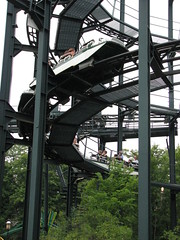 It starts with the trains, which are designed placing riders inline, allowing two people to share in the excitement of the ride together if they wish, and for single riders there is plenty of legroom and the restraints (a loose seatbelt, which there’s always It starts with the trains, which are designed placing riders inline, allowing two people to share in the excitement of the ride together if they wish, and for single riders there is plenty of legroom and the restraints (a loose seatbelt, which there’s always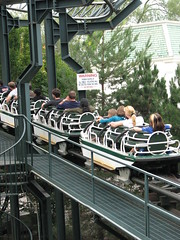 someone who can’t figure it out and holds everyone else up) are as non-restrictive as they come just short of no restraints at all. The low slung sides also allow for one plenty of visual freedom, as well as increasing the sense of exposure to the surroundings as you feel as though you could easily reach out and grab leaves off the trees if you really wanted to. The spiral lift is a relative oddity in this day and age. The motors that power it uphill are located inside the trains someone who can’t figure it out and holds everyone else up) are as non-restrictive as they come just short of no restraints at all. The low slung sides also allow for one plenty of visual freedom, as well as increasing the sense of exposure to the surroundings as you feel as though you could easily reach out and grab leaves off the trees if you really wanted to. The spiral lift is a relative oddity in this day and age. The motors that power it uphill are located inside the trains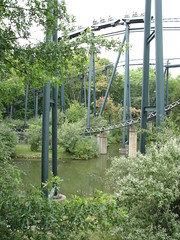 under your seat, although I’m not sure if they’re powered from an electrical strip along the lift or are completely self-contained. Because the lift wraps around three and a half times we have plenty of time to think about the ride ahead before we get to the top. under your seat, although I’m not sure if they’re powered from an electrical strip along the lift or are completely self-contained. Because the lift wraps around three and a half times we have plenty of time to think about the ride ahead before we get to the top.
The first half of the Whizzer is exceptional, with no steep drops to speak of but some long runways that quickly build momentum and let the train fly effortlessly through ground level turns along the forest floor. These are well balanced with slower moments circling around the canopies, allowing time to breath. The first drop in particular can even be a bit intimidating, recalling in some ways the Beast’s incredible finale, with a long, shallow descent accumulating speed before that potential energy explodes into kinetic as it plows around the sharp turn through the trees at the bottom, making me wish momentarily I had more holding me inside than just a flimsy seatbelt.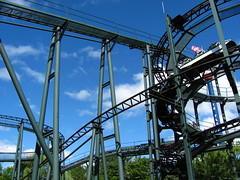
After the bend around the outside of the spiral lift the layout doesn’t thrill me as much. It wanders through some s-curves halfway between ground and sky, finishing the layout with a downward helix. I think Schwarzkopf could have done something better than a helix, that’s a bit too easy and simple a solution, and one that feels a tad overused. Overall the finale doesn’t quite fulfill the promise of the first half, and the ride is slightly uneven in that regard. I imagine young coaster riders might be too frightened by the more intense opening act, and then, once they’ve gotten used to the ride experience there’s nothing new to challenge them in the second half. Or maybe that’s a good thing; first impressions can be scary while last impressions should be joyful, that’s how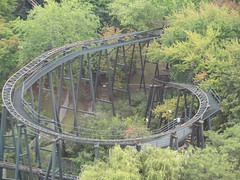 you encourage young enthusiasts to get back in line a second time. you encourage young enthusiasts to get back in line a second time.
Is the Whizzer the best roller coaster in the park? At night, I think possibly so. Between the dense forest, quirky yet comfortable rolling stock, and long layout that’s difficult to memorize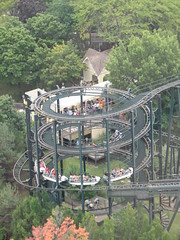 even after multiple laps, it’s where I always tend to find myself heading once the sun starts to dip below the horizon during a day at Great America. The very thought that it was nearly removed for Superman back in 2002 is quite upsetting, but thankfully I was far from alone in these sentiments. Should it ever need to be retired for legitimate reasons, hopefully Six Flags can contract Mack or Gerstlauer to carefully recreate the entire layout with as little disruption to the station and landscape as possible. If they need to introduce new seating configurations to increase capacity I can accept that, and if they want to add a little more spice to the second half of the layout I’d be more than happy. They can scrap X-Flight, they can level Viper, Raging Bull can be relocated to Mars for all I care. Just leave the Whizzer for future generations, and I’ll always have a reason to come back. even after multiple laps, it’s where I always tend to find myself heading once the sun starts to dip below the horizon during a day at Great America. The very thought that it was nearly removed for Superman back in 2002 is quite upsetting, but thankfully I was far from alone in these sentiments. Should it ever need to be retired for legitimate reasons, hopefully Six Flags can contract Mack or Gerstlauer to carefully recreate the entire layout with as little disruption to the station and landscape as possible. If they need to introduce new seating configurations to increase capacity I can accept that, and if they want to add a little more spice to the second half of the layout I’d be more than happy. They can scrap X-Flight, they can level Viper, Raging Bull can be relocated to Mars for all I care. Just leave the Whizzer for future generations, and I’ll always have a reason to come back.
Valencia, California_________________________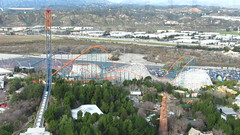
After two full days of light crowds and unlimited roller coasters, I concluded that my time at Magic Mountain had gone far better than I would have set even my highest expectations. This mostly was accounted by the fair California weather that contrasted heavily with the snow and ice I left behind only three days prior, and being granted the freedom to ride whatever I wanted whenever I wanted without needing to plonk down $100 on a Flash Pass. I suspect if the crowds or climes were less ideal (apparently Magic Mountain was coated with snow only a few weeks prior to my arrival)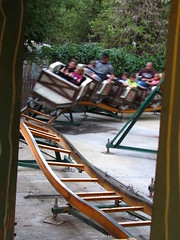 this story could have had a very different tone. But I was lucky, and if there is a moral in all of it, it’s that Magic Mountain in the off-season has the potential to be quite satisfying for the lonely coaster geek. this story could have had a very different tone. But I was lucky, and if there is a moral in all of it, it’s that Magic Mountain in the off-season has the potential to be quite satisfying for the lonely coaster geek.
As a park it’s still very much flawed. Efficiency is not ideal in many of the coaster operations, parts of the park are rather derelict and run-down, and beyond the eighteen roller coasters there are extremely few additional attractions of interest; between two days I rode exactly one (1) non-roller coaster ride. I hear the two log flumes are nice and you can even find a couple of flat rides if you squint really hard, but apart from the children’s areas (which included the Canyon Blaster, coaster #417 for me) there’s virtually no divertissement that’s not gravity-based. (Oh, there are also these gawdawful “coaster wrap” advertisements that have raised the ire of more than one enthusiast. The full banner ads festooned in the Viper station and all over one of the operating trains… for a hair product featuring a dood with a look on his face that says “uh oh, this junk is going to be harder to wash out than a bucket of Sherwin Williams”… was all much too much. Mercifully Viper was the only casualty.) children’s areas (which included the Canyon Blaster, coaster #417 for me) there’s virtually no divertissement that’s not gravity-based. (Oh, there are also these gawdawful “coaster wrap” advertisements that have raised the ire of more than one enthusiast. The full banner ads festooned in the Viper station and all over one of the operating trains… for a hair product featuring a dood with a look on his face that says “uh oh, this junk is going to be harder to wash out than a bucket of Sherwin Williams”… was all much too much. Mercifully Viper was the only casualty.)
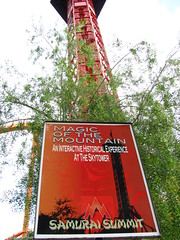 The reason I could tell that Magic Mountain is a park on the rise was by looking at what they did to the 384’ Sky Tower. No, it’s not that they finally resuscitated a park landmark that had been shuttered for over half a decade. It’s not that they took the time and effort to install Magic of the Mountain, a museum of park history on the observation deck… or even that management was receptive enough to take the idea from an employee’s suggestion. It’s the evidence that Six Flags feels comfortable enough with the quality of their product that they can risk to evoke present day comparison against rose-tinted nostalgia. Ten years ago such a museum might have been downright depressing; the carefree times of the fuzzy trolls and Revolution movie cameos contrasted with the cold reality of retina-frying parking lot coasters with three hours worth of hooligans standing in front… particularly embarrassing as the place was known in its nostalgia-saturated early years as “Tragic Mountain”. Upon stepping out of the claustrophobic, slightly vertigo-inducing elevator, the sights on display make this observation deck part satellite and part time machine. Well worth a trip up there, even if you didn’t bring your camera. The reason I could tell that Magic Mountain is a park on the rise was by looking at what they did to the 384’ Sky Tower. No, it’s not that they finally resuscitated a park landmark that had been shuttered for over half a decade. It’s not that they took the time and effort to install Magic of the Mountain, a museum of park history on the observation deck… or even that management was receptive enough to take the idea from an employee’s suggestion. It’s the evidence that Six Flags feels comfortable enough with the quality of their product that they can risk to evoke present day comparison against rose-tinted nostalgia. Ten years ago such a museum might have been downright depressing; the carefree times of the fuzzy trolls and Revolution movie cameos contrasted with the cold reality of retina-frying parking lot coasters with three hours worth of hooligans standing in front… particularly embarrassing as the place was known in its nostalgia-saturated early years as “Tragic Mountain”. Upon stepping out of the claustrophobic, slightly vertigo-inducing elevator, the sights on display make this observation deck part satellite and part time machine. Well worth a trip up there, even if you didn’t bring your camera.

 As a roller coaster reviewer, Revolution leaves me facing a paradox. One that catches me in the conflict between evaluating a ride based on the fundamental constitutive properties or on accidental one-time experience, between intent and results, between the universal and the specific. One that makes me glad I don’t give numeric scores and instead just focus on providing a written analysis that allows for dialogue between viewpoints. As a roller coaster reviewer, Revolution leaves me facing a paradox. One that catches me in the conflict between evaluating a ride based on the fundamental constitutive properties or on accidental one-time experience, between intent and results, between the universal and the specific. One that makes me glad I don’t give numeric scores and instead just focus on providing a written analysis that allows for dialogue between viewpoints.
I happen to really love Revolution. That’s doubtlessly owing to my well-documented affinity for classic parks and attractions, and here is a classic attraction that was a real revolutionary in its time, being the first modern vertical looping roller coaster in 1976.
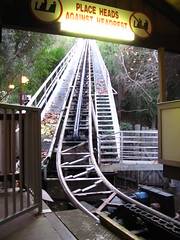 I love the California Mission architecture of the station, the way you enter under and then cross over the beige stucco arch bearing the ride’s emblem. I love the California Mission architecture of the station, the way you enter under and then cross over the beige stucco arch bearing the ride’s emblem.
I love the retro-streamlined look of the cars, especially the newly redecorated stars and stripes train that was regrettably out of service on my visit.
I love the simple but elegant craftsmanship that Schwarzkopf and Intamin used to construct it, the way the minimalist white track and supports disappears into the trees, and not reappearing again until it arrives at the singular, iconic vertical loop staged front and center over Valencia Falls.
I love the use of terrain and vegetation that conceals the layout from view even while riding in the front row, with the compromised tree line from Tatsu’s installation not as bad as I might have imagined. You crest the lift cast in the shadows of California pines, and the first drop down the hillside is veritably an enclosed tunnel of bark and chlorophyll.
 Most of all, I love the dramatic structure of the layout itself. Schwarzkopf, heavily directed by Randall Duell, designed a roller coaster in which every moment is predicated by the others, with not one curve or drop random or happenstance. The narrative utilized is of a very conservative aesthetic that can be clearly (and, I think, deliberately) articulated using conventional story telling terms, starting with the rising action, turning point, climax, falling action and resolution. The layout starts with a series of three curving dives that mirror each other (rising action), a sequence that establishes a pattern while slowly raising the stakes on each iteration: the second two drop further than the first, and the last curve has a stronger lateral whip than the previous two. There is then a pause with a mini block brake that sets up a long descending ramp Most of all, I love the dramatic structure of the layout itself. Schwarzkopf, heavily directed by Randall Duell, designed a roller coaster in which every moment is predicated by the others, with not one curve or drop random or happenstance. The narrative utilized is of a very conservative aesthetic that can be clearly (and, I think, deliberately) articulated using conventional story telling terms, starting with the rising action, turning point, climax, falling action and resolution. The layout starts with a series of three curving dives that mirror each other (rising action), a sequence that establishes a pattern while slowly raising the stakes on each iteration: the second two drop further than the first, and the last curve has a stronger lateral whip than the previous two. There is then a pause with a mini block brake that sets up a long descending ramp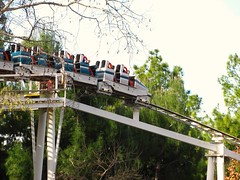 (turning point) that provides a crisp sense of acceleration and hence emotional anticipation of the centerpiece vertical loop (climax). It’s such an effective build-up that by the time I’m inverted 180° I’m thinking “this is soooo cool!”, even though I’ve already been turned upside down 34 times on all the other coasters at Magic Mountain and didn’t think half as much of any of Scream’s gargantuan somersaults. The difference is particularly striking when compared to its east coast sibling the Sooperdooperlooper, which although shares a great deal of the same characteristics, comes off as feeling like a goofy, fun lark with the loop placed right at the beginning of the ride and followed by a grab-bag layout content to wander around the landscape, rather than the disciplined (turning point) that provides a crisp sense of acceleration and hence emotional anticipation of the centerpiece vertical loop (climax). It’s such an effective build-up that by the time I’m inverted 180° I’m thinking “this is soooo cool!”, even though I’ve already been turned upside down 34 times on all the other coasters at Magic Mountain and didn’t think half as much of any of Scream’s gargantuan somersaults. The difference is particularly striking when compared to its east coast sibling the Sooperdooperlooper, which although shares a great deal of the same characteristics, comes off as feeling like a goofy, fun lark with the loop placed right at the beginning of the ride and followed by a grab-bag layout content to wander around the landscape, rather than the disciplined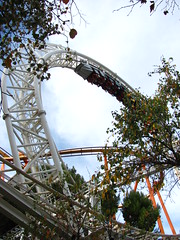 tone-poem of Revolution. This is followed by a couple tone-poem of Revolution. This is followed by a couple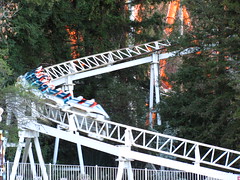 more swooping terrain curves echoing on a smaller scale the first, plus a tunnel (falling action). The train emerges to a long straight away threaded through the loop, allowing ample time to witness what we achieved, and then concluding with a helix finale (resolution). The resolving powers of the helix are literally manifest in the geometry itself, representing the return of a full circle. It’s such a classic and subliminal roller coaster metaphor that the idea of a ‘helix finale’ now risks overexposure and redundancy in most layouts I ride these days that feature it. And now that that has all been said, my paradox… more swooping terrain curves echoing on a smaller scale the first, plus a tunnel (falling action). The train emerges to a long straight away threaded through the loop, allowing ample time to witness what we achieved, and then concluding with a helix finale (resolution). The resolving powers of the helix are literally manifest in the geometry itself, representing the return of a full circle. It’s such a classic and subliminal roller coaster metaphor that the idea of a ‘helix finale’ now risks overexposure and redundancy in most layouts I ride these days that feature it. And now that that has all been said, my paradox…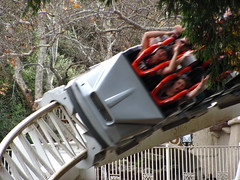
I hated, hated, hated, hated my individual experiences on the Revolution. The three rides I took over two days at the park were the three worst I would have out of any at Magic Mountain. The fact that I rode it three times and didn’t walk away after the first is either a testament to my faith in Schwarzkopf that it was a fluke, or to my latent sadomasochism. It all came down to one thing: those retrofitted over-the-shoulder restraints. I’ve never had as much of a problem with OTSRs as I have on the Revolution’s unnecessary add-ons to the original lapbar-only design. It’s quite clear they were added as a secondary restraining device spurred by a nervous management or insurer after they reasoned that it goes upside down and the laws of centrifugal force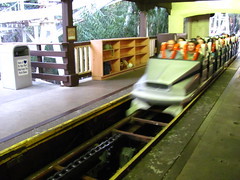 are unlikely to be observed by the rowdy teenage crowd. But because they’re an ad-hoc extension to a vehicle body never designed for shoulder harnesses, they’re fitted much higher than a normal restraint would be and come down nowhere near any actual shoulders unless an NBA player is visiting the park. Instead the bar come right over my ears and the top part of my head, and whenever the cars enter or exit a turn (we’re still dealing with 1970’s design techniques here, before heartlining concepts were fully developed by Stengel) the rock hard foam would knock right into my temple area, sometimes violently. No matter how much I tried to guard against it with defensive riding positions, there was no avoiding it: I would be taking a cranial beating if I wanted to ride the Revolution. The bottom part of the restraints also feature these weird inward spikes are unlikely to be observed by the rowdy teenage crowd. But because they’re an ad-hoc extension to a vehicle body never designed for shoulder harnesses, they’re fitted much higher than a normal restraint would be and come down nowhere near any actual shoulders unless an NBA player is visiting the park. Instead the bar come right over my ears and the top part of my head, and whenever the cars enter or exit a turn (we’re still dealing with 1970’s design techniques here, before heartlining concepts were fully developed by Stengel) the rock hard foam would knock right into my temple area, sometimes violently. No matter how much I tried to guard against it with defensive riding positions, there was no avoiding it: I would be taking a cranial beating if I wanted to ride the Revolution. The bottom part of the restraints also feature these weird inward spikes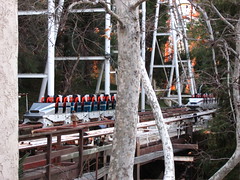 that come down right about at nipple height, which taken altogether made me wonder if the restraints were designed by a dominatrix. that come down right about at nipple height, which taken altogether made me wonder if the restraints were designed by a dominatrix.
There’s no rational reason for this. The only thing they protect against is the nuclear failure of someone falling out completely should the lapbars fail and the train stalls upside down, an incident that has occurred precisely zero times on any of Schwarzkopf’s some 30 looping installations that combined carry millions of passengers per year and have an operating record of 35 years. There’s another version right in Los Angeles with a lapbar only design, two inversions forward and backward, and an artificial, variable acceleration method to achieve the necessary centrifugal force, if the lawyers need a working demonstration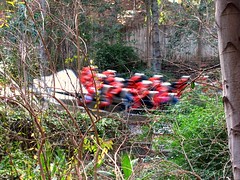 with a long running history and under the same state’s amusement safety legislation. It protects against an imaginary danger. But they actively inflict some lesser form of real injury on nearly every passenger that rides, and because none of these minor injuries could ever be causally linked to any potential litigation, nothing will be done. As long as Six Flags has no motivation to invest in a correction they don’t perceive it as an issue harmful to business, we should be writing them letters letting our feelings be known… or better yet, figure out whoever covers Magic Mountain’s insurance and write them a letter alerting them to the ‘possibility’ of injury. Coaster geeks of the world, unite! Together we are strong… except for in the presence of uncomfortable restraints, and then we’re a cowering coalition of crybabies. with a long running history and under the same state’s amusement safety legislation. It protects against an imaginary danger. But they actively inflict some lesser form of real injury on nearly every passenger that rides, and because none of these minor injuries could ever be causally linked to any potential litigation, nothing will be done. As long as Six Flags has no motivation to invest in a correction they don’t perceive it as an issue harmful to business, we should be writing them letters letting our feelings be known… or better yet, figure out whoever covers Magic Mountain’s insurance and write them a letter alerting them to the ‘possibility’ of injury. Coaster geeks of the world, unite! Together we are strong… except for in the presence of uncomfortable restraints, and then we’re a cowering coalition of crybabies.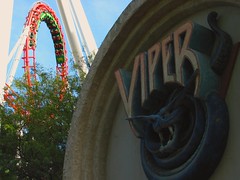
I don’t have anywhere near the same problem with Arrow’s horsecollar restraints. At 5’10” they fit perfectly on me, above the shoulders but below the earlobes, allowing me to enjoy the beautifully awful transitions without any risk of injury or discomfort. Nevertheless I approached Viper slightly apprehensive, though I did admire the presence of the spotless white support structure and vibrant red track looming over the rugged desert landscape. The coaster looks like the year is still 1990, but the empty queue line betrays its true age. Was it really that long ago when the Viper was still a landmark amongst the nation’s thrill rides, especially thanks to its leading role in the old “America’s Greatest Roller Coaster Thrills in 3D” VHS tapes? Did anyone else grow up with those?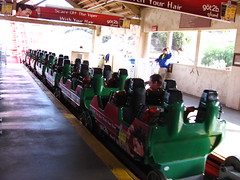 With the fake speed countdowns on the first drops, poorly dubbed scream track recycled on every video, and Ron Toomer’s infamous interview during which he explained that he designs his roller coasters by fiddling with a wire left on his desk? Viper owned that video. For so many years Viper was one of those unattainable dream coasters cruelly constructed on the opposite side of the country from myself. Now I have nearly the entire station platform to myself and it seems so ordinary, but I keep my unique affinity for the Viper over all other Magic Mountain coasters in the back of my mind as I pull down the orange horsecollar and start the intimidating 188’ tall climb skywards, unsure if the ride would live up to its past reputation or if I had reason to fear for my health over the next minute or so. With the fake speed countdowns on the first drops, poorly dubbed scream track recycled on every video, and Ron Toomer’s infamous interview during which he explained that he designs his roller coasters by fiddling with a wire left on his desk? Viper owned that video. For so many years Viper was one of those unattainable dream coasters cruelly constructed on the opposite side of the country from myself. Now I have nearly the entire station platform to myself and it seems so ordinary, but I keep my unique affinity for the Viper over all other Magic Mountain coasters in the back of my mind as I pull down the orange horsecollar and start the intimidating 188’ tall climb skywards, unsure if the ride would live up to its past reputation or if I had reason to fear for my health over the next minute or so.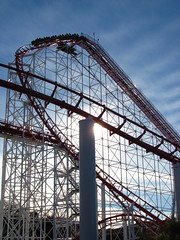
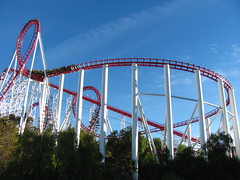 The curving first drop suggests the Arrow mega-coaster has aged fairly well, the wheels all aligned and rolling smoothly, although the physical track still suffers from some hard jolts that indicates Arrow still hadn’t figured out how to calculate variable banking before the end of the 80’s. The first maneuver has the famous profile of the long upward ramp terminating in a vertical loop of roughly the same radius The curving first drop suggests the Arrow mega-coaster has aged fairly well, the wheels all aligned and rolling smoothly, although the physical track still suffers from some hard jolts that indicates Arrow still hadn’t figured out how to calculate variable banking before the end of the 80’s. The first maneuver has the famous profile of the long upward ramp terminating in a vertical loop of roughly the same radius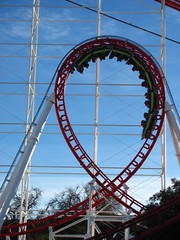 as every other vertical loop Arrow ever built (principles of geometric scaling also being a crippling weakness of Toomer’s). It’s a profile I sort of like as the inversion is much more disorienting force-wise than it would have been if long and drawn out as they finally figured out on the Tennessee Tornado. That’s good for me as there’s two more of these loops just around the lightning elevated turnaround. All good fun, although the third loop has a rather bad bump at the top as if Ron pinched a point too hard when forming his coat hangers. as every other vertical loop Arrow ever built (principles of geometric scaling also being a crippling weakness of Toomer’s). It’s a profile I sort of like as the inversion is much more disorienting force-wise than it would have been if long and drawn out as they finally figured out on the Tennessee Tornado. That’s good for me as there’s two more of these loops just around the lightning elevated turnaround. All good fun, although the third loop has a rather bad bump at the top as if Ron pinched a point too hard when forming his coat hangers.
Aside from the hair product advertisements that jolt is the most offensive moment on the entire ride. The momentum is halted for a midcourse brake run, and then it slowly picks up speed again on a shallow serpentine descent that sets up the double-inversion batwing element quite nicely. This element can be a little bit jarring but it’s also my favorite of the ride if only for the increasing rarity. There’s then a cactus-clipping ground level curve that feeds into the barrel of the double corkscrew, copied and pasted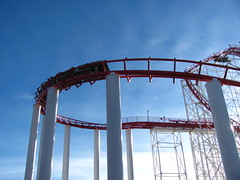 directly from the blueprints of Knott’s miniscule corkscrew originator. That’s the principle setback with the Arrow mega-looping coaster designs. Since they don’t adjust the scale of the inversions from the standard issue, the ride feels progressively smaller until a 70 mph monster is imitating verbatim a 70 foot tall compact production model. Although smaller and older, King’s Island’s Vortex manages this better with the aerial corkscrews threading the loops and then rapidly descending into a partly subterranean batwing as a grand climax. There’s no such rush to the finish line on Viper; after the corkscrews there’s an extemporaneous stretch directly from the blueprints of Knott’s miniscule corkscrew originator. That’s the principle setback with the Arrow mega-looping coaster designs. Since they don’t adjust the scale of the inversions from the standard issue, the ride feels progressively smaller until a 70 mph monster is imitating verbatim a 70 foot tall compact production model. Although smaller and older, King’s Island’s Vortex manages this better with the aerial corkscrews threading the loops and then rapidly descending into a partly subterranean batwing as a grand climax. There’s no such rush to the finish line on Viper; after the corkscrews there’s an extemporaneous stretch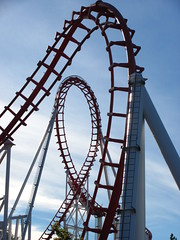 of track over some uneven desert terrain (which I actually liked just for being a different pace) back to the station. As much as I like of track over some uneven desert terrain (which I actually liked just for being a different pace) back to the station. As much as I like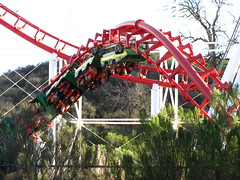 to champion classic Arrow Dynamic roller coasters, I’d be lying if I said this ride were an underrated gem that lived up to my childhood day dreams. But it’s still an indomitable thrill machine, and when I found an empty set of air gates upon my return I stayed seated, even enjoying it enough to repeat thrice more. And of all the coasters in the park with seven inversions, Viper is the best. to champion classic Arrow Dynamic roller coasters, I’d be lying if I said this ride were an underrated gem that lived up to my childhood day dreams. But it’s still an indomitable thrill machine, and when I found an empty set of air gates upon my return I stayed seated, even enjoying it enough to repeat thrice more. And of all the coasters in the park with seven inversions, Viper is the best.
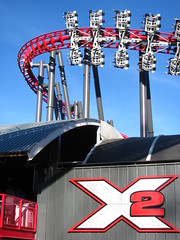 I will, however, be championing the modern Arrow Dynamic roller coaster that’s situated directly to the left: the dark, sinister complement to Viper’s bright white dexterity, X2. The 2008 re-launch of the original 4D prototype saw new and improved trains, paint, soundtrack, flamethrowers and an overarching philosophy to tie it all together. I interpreted it to be this: More than just a roller coaster, X2 is a kinetic metaphor of our simultaneous terror of and attraction to the unstoppable behemoth that is popular culture. As a hypermasculine Beelzebub incarnate that inhales sulfur and exhales rock ‘n’ roll, it dwarfs anyone who dares not to surrender to its awesome but horrible power. God is not dead, the ancient deities are still alive today in the faces of mass media, controlling human destiny with the electric bolts pulsing through the information superhighway, and Los Angeles is the modern Pop Pantheon from which the Gods reign supreme. But is it these Pop Gods that have created us, or did we create these Gods? We recognize that this culture is entirely mortal-produced; in fact I am responsible for its creation, participants all of us in the market economy and all of its destructive tendencies. But what is destruction but another form of creation? I will, however, be championing the modern Arrow Dynamic roller coaster that’s situated directly to the left: the dark, sinister complement to Viper’s bright white dexterity, X2. The 2008 re-launch of the original 4D prototype saw new and improved trains, paint, soundtrack, flamethrowers and an overarching philosophy to tie it all together. I interpreted it to be this: More than just a roller coaster, X2 is a kinetic metaphor of our simultaneous terror of and attraction to the unstoppable behemoth that is popular culture. As a hypermasculine Beelzebub incarnate that inhales sulfur and exhales rock ‘n’ roll, it dwarfs anyone who dares not to surrender to its awesome but horrible power. God is not dead, the ancient deities are still alive today in the faces of mass media, controlling human destiny with the electric bolts pulsing through the information superhighway, and Los Angeles is the modern Pop Pantheon from which the Gods reign supreme. But is it these Pop Gods that have created us, or did we create these Gods? We recognize that this culture is entirely mortal-produced; in fact I am responsible for its creation, participants all of us in the market economy and all of its destructive tendencies. But what is destruction but another form of creation?
At the heart of this terror, when confronting X2 one is made to feel insignificant. It’s impossible to comprehend that which encompasses our entire constitutive being. The towering blood red and charcoal gray Olympus is unfathomably massive, in scale, technology and expense; all flowing with a pop-synergy that’s built from exabytes of cultural discourse which no one player controls. And yet as the banner hanging in this “Coliseum of Thrill” reminds: “here you stand”. This reality is all your experience. No one else, not even God, can take that away from you. You were born alone, you will die alone, and you will ride X2 alone. Although the ride operators will do their best to pair single riders.
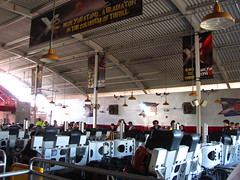 The station is an impressive sight to behold: the giant air-hangar-like structure built to encompass the massive, 20-foot wide trains. Overhead is an enormous LED screen replaying the animated promotional video of the coaster which depicts the ride in an even darker and epic nature than it already is, while meanwhile the speakers play a creepily ambient mix of an echoing female voice whispering “X2”, a male voice repeating (each time a tone lower) “Is everybody in? Is everybody in? The ceremony is about to begin…” The one place where Six Flags messed up was in the lighting. For some reason all the lights in the station are a flat white, when I would have expected at least red or ultraviolet filters, if not an expensive show-lighting package. Such a simple change would have made such a dramatic improvement in the The station is an impressive sight to behold: the giant air-hangar-like structure built to encompass the massive, 20-foot wide trains. Overhead is an enormous LED screen replaying the animated promotional video of the coaster which depicts the ride in an even darker and epic nature than it already is, while meanwhile the speakers play a creepily ambient mix of an echoing female voice whispering “X2”, a male voice repeating (each time a tone lower) “Is everybody in? Is everybody in? The ceremony is about to begin…” The one place where Six Flags messed up was in the lighting. For some reason all the lights in the station are a flat white, when I would have expected at least red or ultraviolet filters, if not an expensive show-lighting package. Such a simple change would have made such a dramatic improvement in the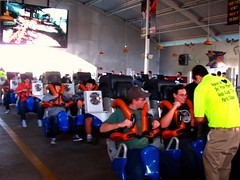 ominous ambiance. The fact that the pre-ride atmosphere is still fairly tense is a testament to how effective the presentation has been so far; basically it just has to look really freakin’ expensive for the subliminal aesthetic to take hold, something Magic Mountain did quite well. The new trains, in a bid to keep weight to a minimum for a smoother ride, have far less ornamentation than the old ones (with the big purple fiberglass “X” casings) but to greater visual effect. Not hiding the technology behind the ride is another psychological mindgame X2 plays before we’re ready to depart, the complicated inner workings teasing us to put it in a perspective we can understand. The restraints are an unusual but effective design, with two halves of “butterfly wings” folding around the sides and sliding downward on a vertical accordion spring ominous ambiance. The fact that the pre-ride atmosphere is still fairly tense is a testament to how effective the presentation has been so far; basically it just has to look really freakin’ expensive for the subliminal aesthetic to take hold, something Magic Mountain did quite well. The new trains, in a bid to keep weight to a minimum for a smoother ride, have far less ornamentation than the old ones (with the big purple fiberglass “X” casings) but to greater visual effect. Not hiding the technology behind the ride is another psychological mindgame X2 plays before we’re ready to depart, the complicated inner workings teasing us to put it in a perspective we can understand. The restraints are an unusual but effective design, with two halves of “butterfly wings” folding around the sides and sliding downward on a vertical accordion spring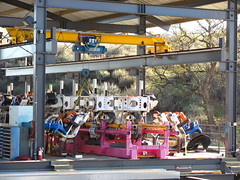 to rest at the perfect height, ensuring a secure fit that’s minimally intrusive to the ragdoll flailing of hands, legs and neck that we’ll be doing. On my first ride I found myself fumbling for a seatbelt or something to go over my lap. There wasn’t any. While your chest is secure, the lower part of your body remains surprisingly vulnerable, a sensation more discomforting than freeing as we’re released from the station and sent around the first curve in reverse. to rest at the perfect height, ensuring a secure fit that’s minimally intrusive to the ragdoll flailing of hands, legs and neck that we’ll be doing. On my first ride I found myself fumbling for a seatbelt or something to go over my lap. There wasn’t any. While your chest is secure, the lower part of your body remains surprisingly vulnerable, a sensation more discomforting than freeing as we’re released from the station and sent around the first curve in reverse.
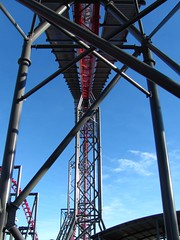 The mark of a truly great ride is that it provides a complete experience before the meaty visceral action has even begun. X2 is the grand champion of this strategy, marrying an excellent, multi-stage introduction that teases out even the slightest of psychological anxieties to a main sequence that genuinely does bite as loud as it barks. On my first ride I was a bit nervous anyway as I had no idea what a 4D coaster experience would feel like, while knowing that X2 had a love-it-or-hate-it reputation but not yet knowing which camp I would fall into. Once on the first curve when it’s time to do-or-die, the on-board soundtrack rings in a tinny recording of “It Had To Be You”, of all things. The seats seem to nervously swivel onto their backs, demonstrating the forth-rail technology for us a bit, and then it’s into the lift hill. Sinatra’s voice gives way to an electronic crackle, a voice rhetorically questions “are you ready?”, The mark of a truly great ride is that it provides a complete experience before the meaty visceral action has even begun. X2 is the grand champion of this strategy, marrying an excellent, multi-stage introduction that teases out even the slightest of psychological anxieties to a main sequence that genuinely does bite as loud as it barks. On my first ride I was a bit nervous anyway as I had no idea what a 4D coaster experience would feel like, while knowing that X2 had a love-it-or-hate-it reputation but not yet knowing which camp I would fall into. Once on the first curve when it’s time to do-or-die, the on-board soundtrack rings in a tinny recording of “It Had To Be You”, of all things. The seats seem to nervously swivel onto their backs, demonstrating the forth-rail technology for us a bit, and then it’s into the lift hill. Sinatra’s voice gives way to an electronic crackle, a voice rhetorically questions “are you ready?”,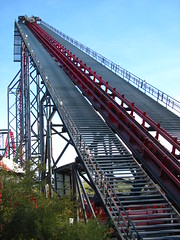 and then the real rock-and-roll begins. and then the real rock-and-roll begins.
The brilliance of this beginning is partly inherent in the ride’s design: we’re traveling backwards so there’s no way to see how much farther there is to go before we’re at the precipice of a sheer vertical dive. Instead we get to watch the earth move farther away below us, the coaster is situated on top of a hill so we can see the entire postmodern steel landscape of Magic Mountain laid out in front of us, the parallax slowly shrinking it into miniature as we inch further up and away (everyone gets a clear view no matter the seat). The serene, God-like perspective is contrasted with the rock music overlaid with a hyperactive collage of movie quotes, notably from R. Lee Ermey’s intense drill sergeant from Full Metal Jacket (Featured: “I’ve got your name! You will not laugh, you will not cry!” Not Featured: “Do you suck dicks? I bet you could suck a golf ball through a garden hose!”). It is here where that philosophy espoused in the review’s opening paragraphs is most immediate; the panoptic scale of the physical and pop-cultural environment simultaneously highlights while rendering infinitesimal the weight of individual experience.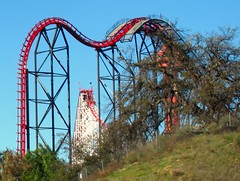
It comes to a head when we crest the 215’ lift hill, the world (both visual and audible) abruptly disappears from view, and all that remains is the sound of a heartbeat. We know we’re sitting on a razor’s edge, and our 5-ton train has just now been released to the influence of gravity alone, but the enormous bubble of tension can’t be popped just yet. There’s a small fake-out drop and rise before getting to the main drop, during which our seats rotate us forward so we’re now in a backwards flying position staring straight down at the ground over 200 feet below. Holy crap. I’m staring down a vertical red column that I realize is our track, and suddenly Aerosmith cuts in with “goooooing down” and our train plummets 90°. The seats flip us a further 90° so we’re falling head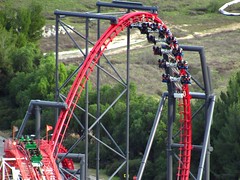 first upside down. We flip onto our backs just before hitting the bottom, a smooth 76 mph pullout that demonstrates an unbelievable amount of force and power. Just as smoothly we surge straight upward and over into the first raven turn, a vertical half-loop of sorts that the rotating seats keep us upright over the entire arc. This produces some spectacular airtime over the crest (remember, there’s nothing over your lap so you are out of your seat), and as the entire twisted metal salad of track comes into view with nothing above or below me, I can only yell out one thing: “FUCK YEAH!!!” first upside down. We flip onto our backs just before hitting the bottom, a smooth 76 mph pullout that demonstrates an unbelievable amount of force and power. Just as smoothly we surge straight upward and over into the first raven turn, a vertical half-loop of sorts that the rotating seats keep us upright over the entire arc. This produces some spectacular airtime over the crest (remember, there’s nothing over your lap so you are out of your seat), and as the entire twisted metal salad of track comes into view with nothing above or below me, I can only yell out one thing: “FUCK YEAH!!!”
From the station to the first raven turn is probably about the most mind-blowing start to a roller coaster I’ve ever come across. After this it lets off the gas a bit (the music is all but inaudible by this point, not that anyone could remember to listen for it), although the next element is still keeping in the spirit. There’s a small, low camelback hill similar in profile to nearby Goliath’s, only the trains take advantage of the near-weightlessness to do a breezy backward somersault courtesy of the secondary set of rails. This is probably the best moment to savor the 4D selling point; at other times when it’s in use it can be hard to tell exactly what’s going on. The next maneuver, a “luge turn” (sort of a shallow fan curve with the rotating seats tipped on their backs so riders glide through it luge-style) slows the pace down for a moment’s breather, although it’s also the point where Arrow most messed up their analysis by trying to build a heartlined transition into the banking with trains that can’t heartline due to the 20-foot span, so there’s a bit by this point, not that anyone could remember to listen for it), although the next element is still keeping in the spirit. There’s a small, low camelback hill similar in profile to nearby Goliath’s, only the trains take advantage of the near-weightlessness to do a breezy backward somersault courtesy of the secondary set of rails. This is probably the best moment to savor the 4D selling point; at other times when it’s in use it can be hard to tell exactly what’s going on. The next maneuver, a “luge turn” (sort of a shallow fan curve with the rotating seats tipped on their backs so riders glide through it luge-style) slows the pace down for a moment’s breather, although it’s also the point where Arrow most messed up their analysis by trying to build a heartlined transition into the banking with trains that can’t heartline due to the 20-foot span, so there’s a bit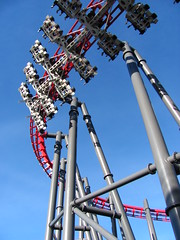 of a lurch on the entry and exit of this turn. There’s also an odd moment where I realize, “weren’t we going backward at the beginning of the ride?” That’s explained by the inverted track with the seats technically rotated upside down as well. It pays off with the half barrel roll that follows. This is not as extreme a maneuver as it could be imagined to be. Since we’re kept upright through the whole thing, it feels more like a simple 90° banked turn than anything else, albeit one in the geometric space of an M.C. Escher drawing. At the bottom are a set of flame throwers which were the only special of a lurch on the entry and exit of this turn. There’s also an odd moment where I realize, “weren’t we going backward at the beginning of the ride?” That’s explained by the inverted track with the seats technically rotated upside down as well. It pays off with the half barrel roll that follows. This is not as extreme a maneuver as it could be imagined to be. Since we’re kept upright through the whole thing, it feels more like a simple 90° banked turn than anything else, albeit one in the geometric space of an M.C. Escher drawing. At the bottom are a set of flame throwers which were the only special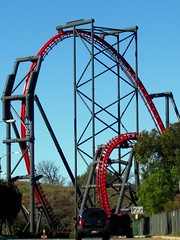 effect from the original make-over announcement to actually get installed (fog and tunnels were also promised but never materialized), and generally only improve the ride experience at night. During the day you’re looking up at the sun anyway so they’re easy to miss especially if they’re not timed right. There’s one more raven turn, not as epic as the big brother next to it but features some strong G-forces due to the tight circumference, and then a second half barrel roll, also smaller (but not more forceful) than the first. The train slides into the brakes and the ride is over, Rage Against The Machine pounding over the speakers to congratulate our accomplishment. In some respects it is a silly and overly macho tone for a ride, perpetuating the unfortunately one-sided gender preference of the roller coaster hobby, but it still hit a nerve in me and I was grinning ear to ear when we got back. effect from the original make-over announcement to actually get installed (fog and tunnels were also promised but never materialized), and generally only improve the ride experience at night. During the day you’re looking up at the sun anyway so they’re easy to miss especially if they’re not timed right. There’s one more raven turn, not as epic as the big brother next to it but features some strong G-forces due to the tight circumference, and then a second half barrel roll, also smaller (but not more forceful) than the first. The train slides into the brakes and the ride is over, Rage Against The Machine pounding over the speakers to congratulate our accomplishment. In some respects it is a silly and overly macho tone for a ride, perpetuating the unfortunately one-sided gender preference of the roller coaster hobby, but it still hit a nerve in me and I was grinning ear to ear when we got back.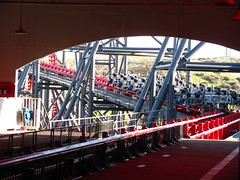
Yet if I sound a bit less enthused about the rest of the ride after the first raven turn, that’s because I am less enthused. The first drop is where all the really imaginative uses of the 4D technology are put to use, and as the scale diminishes so does the ambition to really experiment with the technology. As crazy as the independent axis seats sound on paper, the truth is that for the majority of the layout they’re used to neutralize and control the experience, not to add anything more to it. There are only two times when riders are upside down, both happen within the first half of the ride action. I feel like the second raven turn and/or one of the half rolls are crying out for a 540° seat rotation rather than a simple 180°. This isn’t even much of a criticism in itself – 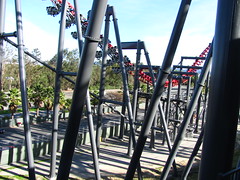 there’s only so much you can take in a single ride before some riders will reach their threshold and need it to slow down for the remainder in order to enjoy it – but the second half of the layout was also marred by some rather unpleasant vibrations in the winged seating arrangement (particularly through the half-roll and into the second raven turn), strangely not present on the high-speed sections early in the ride. That brings up one of the primary points of contention regarding X2: Is it rough? there’s only so much you can take in a single ride before some riders will reach their threshold and need it to slow down for the remainder in order to enjoy it – but the second half of the layout was also marred by some rather unpleasant vibrations in the winged seating arrangement (particularly through the half-roll and into the second raven turn), strangely not present on the high-speed sections early in the ride. That brings up one of the primary points of contention regarding X2: Is it rough?
In a word, yes. However, even before I ever rode it myself I was surprised by how many enthusiasts wrote that they found it extremely rough but still loved it anyway and put it near the top of their lists of best roller coasters. Normally that sort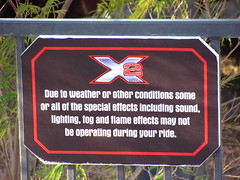 of reception is unheard of amidst enthusiast circles – if it’s rough, the ride is flat out of luck – so I knew I had to be dealing with something pretty awesome (and as my review indicates, I agree). I’m even uncomfortable using the term ‘rough’ to describe X2 since I think that leaves out a bit of color as to exactly what sort of experience you get. It’s certainly not rough in the loose wheel grip notion that many older Arrow coasters encounter, nor is it from a coat hanger trackwork quality (except for the transitions in the luge-turn of reception is unheard of amidst enthusiast circles – if it’s rough, the ride is flat out of luck – so I knew I had to be dealing with something pretty awesome (and as my review indicates, I agree). I’m even uncomfortable using the term ‘rough’ to describe X2 since I think that leaves out a bit of color as to exactly what sort of experience you get. It’s certainly not rough in the loose wheel grip notion that many older Arrow coasters encounter, nor is it from a coat hanger trackwork quality (except for the transitions in the luge-turn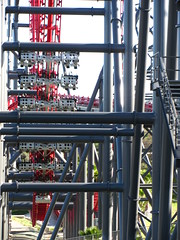 as already noted, something S&S Arrow would figure out a solution for on their next coaster, Eejanaika). It’s at its worst during the vertical oscillation as already noted, something S&S Arrow would figure out a solution for on their next coaster, Eejanaika). It’s at its worst during the vertical oscillation of the winged seating when it can kinda hurt the base of your neck, and when it’s running well that roughness really just implies a much higher than average level of intensity and aggressiveness, which I wouldn’t categorize as roughness but rather a deliberate design feature. There do seem to be some issues with the double rail, rack-and-pinion gear system that allows the seats of the winged seating when it can kinda hurt the base of your neck, and when it’s running well that roughness really just implies a much higher than average level of intensity and aggressiveness, which I wouldn’t categorize as roughness but rather a deliberate design feature. There do seem to be some issues with the double rail, rack-and-pinion gear system that allows the seats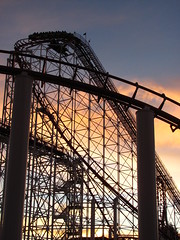 to rotate, like the tolerances are too loose allowing for some unpredicted drift in the seat rotation. This was mostly observed in the low-speed zones, particularly the turn out of the station when the seats shuttered back and forth a bit, though once it picked up speed this ceased to be as much of a problem (contrary to expectations, as I would think high speeds would magnify such issues rather than tone them down) . Perhaps this also relates to why the section of track along the far back run was rougher than the rest. However, the last ride I would take between my two days at Magic Mountain at night was in the back row of X2, and our vehicles whistled through the course like it was the easiest thing in the world, a final encounter in which everything played out so perfectly that my appetite was well-whetted for a return to Valencia’s iron playground before I had even stepped off the exit platform for the very last time. It was a wild, crazy, insane experience… like Jekyll and Hyde. to rotate, like the tolerances are too loose allowing for some unpredicted drift in the seat rotation. This was mostly observed in the low-speed zones, particularly the turn out of the station when the seats shuttered back and forth a bit, though once it picked up speed this ceased to be as much of a problem (contrary to expectations, as I would think high speeds would magnify such issues rather than tone them down) . Perhaps this also relates to why the section of track along the far back run was rougher than the rest. However, the last ride I would take between my two days at Magic Mountain at night was in the back row of X2, and our vehicles whistled through the course like it was the easiest thing in the world, a final encounter in which everything played out so perfectly that my appetite was well-whetted for a return to Valencia’s iron playground before I had even stepped off the exit platform for the very last time. It was a wild, crazy, insane experience… like Jekyll and Hyde.
Next: Knott’s Berry Farm and Adventure City.
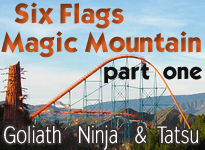 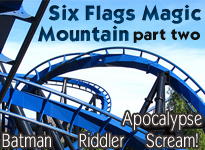 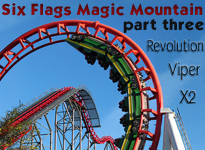
Six Flags Great America – Gurnee, Illinois
Whizzer
 Is there no pride left in being a family coaster? Have we really gotten to the point that if a park wants to add a family ride it has to be brief, compact, brightly colored and spinning? What happened to the days when a coaster could be a genuine work of art while still being accessible to entry-level riders? With Big Bad Wolf now gone the Whizzer could very well be the best example of a classical family coaster that’s just as appreciated whether it’s your first coaster or your four-hundredth. Whizzer could even be the best coaster in the park. I’m not sure if I would personally make that claim (see below) but it’s not hard to see how someone could. From the layout to the rolling stock to the natural setting in the center of the park (did that land really used to be a flat cleared field?) the Whizzer is full of unique character. Is there no pride left in being a family coaster? Have we really gotten to the point that if a park wants to add a family ride it has to be brief, compact, brightly colored and spinning? What happened to the days when a coaster could be a genuine work of art while still being accessible to entry-level riders? With Big Bad Wolf now gone the Whizzer could very well be the best example of a classical family coaster that’s just as appreciated whether it’s your first coaster or your four-hundredth. Whizzer could even be the best coaster in the park. I’m not sure if I would personally make that claim (see below) but it’s not hard to see how someone could. From the layout to the rolling stock to the natural setting in the center of the park (did that land really used to be a flat cleared field?) the Whizzer is full of unique character.
It starts with the trains, which are designed placing riders inline, allowing two people to share in the excitement of the ride together if they wish, and for single riders there is plenty of legroom and the restraints (basically a seatbelt and that’s it) are as non-restrictive as they come without being altogether missing. The low-slung sides also allow for one plenty of visual freedom, as well as increasing the sense of exposure to the surroundings as you feel as though you could easily reach out and grab leaves off the trees if you really wanted to. The spiral lift is an oddity in itself and is a unique way to start the ride off. The motors that power it uphill are actually located inside the trains, although I’m not sure if they’re powered from an electrical strip running along the lift or are completely self-contained (I’m guessing the former). It takes a while to get to the top as well, not because the motor is slow but because it takes so much track to wrap around three and a half times that it can take well over a minute before we get to the top. and the restraints (basically a seatbelt and that’s it) are as non-restrictive as they come without being altogether missing. The low-slung sides also allow for one plenty of visual freedom, as well as increasing the sense of exposure to the surroundings as you feel as though you could easily reach out and grab leaves off the trees if you really wanted to. The spiral lift is an oddity in itself and is a unique way to start the ride off. The motors that power it uphill are actually located inside the trains, although I’m not sure if they’re powered from an electrical strip running along the lift or are completely self-contained (I’m guessing the former). It takes a while to get to the top as well, not because the motor is slow but because it takes so much track to wrap around three and a half times that it can take well over a minute before we get to the top.
The first half of the Whizzer is exceptional, with no steep drops to speak of but some long runways that quickly build momentum and lets the train fly effortlessly through ground-level turns along the forest floor. These are well-balanced with slower moments circling around the canopies, allowing time to breath. The first drop in particular can even be a bit intimidating, recalling in some ways the Beast’s incredible finale, with a long, shallow descent accumulating speed before that potential energy explodes into kinetic as it plows around the sharp turn through the trees at the bottom, making me wish for a moment I had more holding me into the trains than just this flimsy little seatbelt.
 After this first half and it makes its way around the lift, the coaster doesn’t thrill me as much. It wanders through some s-turns halfway between ground and sky, finishing the layout with a downward helix. I think Schwarzkopf could have done something better than a helix, that’s a bit too easy and simple a solution, and one that feels a tad overused. Overall I think the finale doesn’t quite fulfill the promise of the first half, and the ride is slightly uneven in that regard, since I imagine young coaster riders might be too frightened by the more intense opening act, and then, once they’ve gotten used to the ride experience, there’s nothing new to challenge them in the second half. After this first half and it makes its way around the lift, the coaster doesn’t thrill me as much. It wanders through some s-turns halfway between ground and sky, finishing the layout with a downward helix. I think Schwarzkopf could have done something better than a helix, that’s a bit too easy and simple a solution, and one that feels a tad overused. Overall I think the finale doesn’t quite fulfill the promise of the first half, and the ride is slightly uneven in that regard, since I imagine young coaster riders might be too frightened by the more intense opening act, and then, once they’ve gotten used to the ride experience, there’s nothing new to challenge them in the second half.
Still, the setting is fantastic, and the places along the course where there’s not as many trees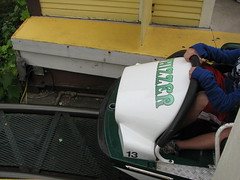 as I’d like only highlight how dense the foliage is around some of the other parts. Needless to say, this was the one coaster I wanted to end the day with, and the nighttime atmosphere does improve the ride a great deal, even if there are a few more lights along the course than I would have liked. Overall this is still a must-ride for anyone visiting the park, whether you’re a thrill seeker normally only interested in the headlining B&M attractions or new to roller coasters altogether. The very thought that this could have been removed for Superman back in 2002 is quite upsetting, but clearly I was not alone in those sentiments as the ride remains running to this day. as I’d like only highlight how dense the foliage is around some of the other parts. Needless to say, this was the one coaster I wanted to end the day with, and the nighttime atmosphere does improve the ride a great deal, even if there are a few more lights along the course than I would have liked. Overall this is still a must-ride for anyone visiting the park, whether you’re a thrill seeker normally only interested in the headlining B&M attractions or new to roller coasters altogether. The very thought that this could have been removed for Superman back in 2002 is quite upsetting, but clearly I was not alone in those sentiments as the ride remains running to this day.
Demon
If all of Six Flags Great America’s coasters went to high school, Demon would be the shrimpy nerdy one that’s convinced he’s really the most totally awesome thing since the invention of the printing press. It’s got the all-black paint scheme with goofy rock-face structures, two special effects tunnels that try to dazzle and impress even though they used these big, carnival style incandescent light bulb strips, and of course the old “Demon Song” was playing all over the station. Step into the Demon queue and you’ll be directly transported back into 1979.
The coaster itself is a pretty decent riding experience. I got a couple late evening/early night rides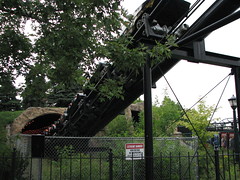 and that really improved the ride experience in the tunnels and out on the farther unlit portions of the course. You do have to be of a certain height to enjoy these Arrow looping coasters, as too short can mean the horsecollar restraints connect with your earlobes, and too tall means they fit uncomfortably tight on top of your shoulders. If you’re in the intended height range then the first drop and two loops can be a fun, intense and dizzying affair. I’d be curious to know how it was back when it was the Turn of the Century and had two camelback hills where the loops are today; they looked like more extreme versions of Cedar Point’s Corkscrew’s single air hill and that one is quite intense by itself. and that really improved the ride experience in the tunnels and out on the farther unlit portions of the course. You do have to be of a certain height to enjoy these Arrow looping coasters, as too short can mean the horsecollar restraints connect with your earlobes, and too tall means they fit uncomfortably tight on top of your shoulders. If you’re in the intended height range then the first drop and two loops can be a fun, intense and dizzying affair. I’d be curious to know how it was back when it was the Turn of the Century and had two camelback hills where the loops are today; they looked like more extreme versions of Cedar Point’s Corkscrew’s single air hill and that one is quite intense by itself.
Things like the long straightaway in the special effects tunnel after the loops do help make the ride experience a fun one, cheesy as they are. The second half after the tunnel doesn’t have quite as much going for it as the first, the turnaround taking a while to get through and then the corkscrews over the railroad tracks and final helix are both a bit slower paced and a bit rougher, but it helps round out the ride experience to feel more complete than some of the other early small-scale Arrow multiloopers that charge through the course in less than 45 seconds. Honestly I don’t miss the Shockwave at all since the park still has the Demon, whose mixture of low-key, small scale thrills with a larger-than-life persona and a full-on 80’s cheese fest, make it one of the most purely fun coasters in Six Flags Great America. in the special effects tunnel after the loops do help make the ride experience a fun one, cheesy as they are. The second half after the tunnel doesn’t have quite as much going for it as the first, the turnaround taking a while to get through and then the corkscrews over the railroad tracks and final helix are both a bit slower paced and a bit rougher, but it helps round out the ride experience to feel more complete than some of the other early small-scale Arrow multiloopers that charge through the course in less than 45 seconds. Honestly I don’t miss the Shockwave at all since the park still has the Demon, whose mixture of low-key, small scale thrills with a larger-than-life persona and a full-on 80’s cheese fest, make it one of the most purely fun coasters in Six Flags Great America.
Viper
I was looking forward to this one. I really liked it back in 2003, but wasn’t so keen on it in 2005 when it seemed much rougher. However most of the reviews I read online seemed to corroborate better with my 2003 opinion, saying it tracks incredibly well and even that it could be Six Flag’s best wooden coaster after El Toro. After getting three rides on it this year (back row, front row and 1-3) I have to say that while the first part of those claims is very true (that it’s very smooth and well-maintained) I can’t agree with the second part. As another Cyclone-clone, this one seemed relatively conservative and didn’t do much for me.
It’s still a very fun ride, and easily accessible to people unsure about wooden coasters. The station and setting is great, the structure looks magnificent from off-ride, the two thirty-passenger trains keep the line moving, and best of all it is impeccably maintained. It feels like luxury shock absorbers have been retrofitted to the trains, so smooth do we sail over airtime hills and turns with no loss of pace due to potholing or shuffling that normally plagues wooden coasters from this era. I couldn’t be sure but it appeared as though there were more layers of wood that make up the track than on normal wooden coasters. and easily accessible to people unsure about wooden coasters. The station and setting is great, the structure looks magnificent from off-ride, the two thirty-passenger trains keep the line moving, and best of all it is impeccably maintained. It feels like luxury shock absorbers have been retrofitted to the trains, so smooth do we sail over airtime hills and turns with no loss of pace due to potholing or shuffling that normally plagues wooden coasters from this era. I couldn’t be sure but it appeared as though there were more layers of wood that make up the track than on normal wooden coasters.
So why do I merely give it a passing grade? I think it was just that the coaster lacked much bite. The bookending fan turns in particular were a bit of a snooze,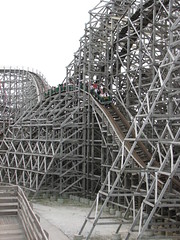 the first one with very gentle lead-ins/outs taking far too long to complete, and the others feeling very controlled and forceless as well. There was none of the sharp snaps over the crests of the dives that I loved on the Georgia Cyclone. The centerpiece airtime hills and drops were a bit better, but again in all seats they lacked any sort of aggressiveness, instead opting for smooth, sustained floater air. That’s alright in most cases, but not for a ride based on the Cyclone where I expect more out-of-control intensity. Regardless, this isn’t the ideal layout for that type of airtime since only one or two hills are achieved before the pace has to halt for another fan turn that accomplishes little besides turning the train around again. Probably the most effective moment was the double dip off the second turn and the sharp, straight camelback hill buried in the lift super structure that followed. Intense, yes. Aggressive, not quite; the transitions were still feather-light and lacked the snap I normally associate with these rides. It’s not enough to just be held out of my seat, I want to be jolted out of it. Maybe it was just a case of having the wrong expectations, but I personally would take the other, edgier Cyclone counterparts over this one any day of the week. the first one with very gentle lead-ins/outs taking far too long to complete, and the others feeling very controlled and forceless as well. There was none of the sharp snaps over the crests of the dives that I loved on the Georgia Cyclone. The centerpiece airtime hills and drops were a bit better, but again in all seats they lacked any sort of aggressiveness, instead opting for smooth, sustained floater air. That’s alright in most cases, but not for a ride based on the Cyclone where I expect more out-of-control intensity. Regardless, this isn’t the ideal layout for that type of airtime since only one or two hills are achieved before the pace has to halt for another fan turn that accomplishes little besides turning the train around again. Probably the most effective moment was the double dip off the second turn and the sharp, straight camelback hill buried in the lift super structure that followed. Intense, yes. Aggressive, not quite; the transitions were still feather-light and lacked the snap I normally associate with these rides. It’s not enough to just be held out of my seat, I want to be jolted out of it. Maybe it was just a case of having the wrong expectations, but I personally would take the other, edgier Cyclone counterparts over this one any day of the week.
American Eagle
Asked me before I left I would have said no. Asked me after my first ride I would have said unlikely. But asked me at the end of the day, after three consistently great rides on it, what my vote for best roller coaster in the park would be, I would have to give it to the American Eagle. Surprised? Me too!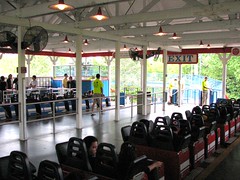
This was not a coaster I liked much before, or ever gave much thought to it. Which genius was it that thought a gigantic helix in the middle of a twin-tracked coaster would be a good element to ensure evenly timed races? The plus-plus-sized heights and speeds only meant that a): the fast parts would be all the more rough and unbearable, and b): they would quickly be braked, turning it into one of those overscaled lame duck monstrosities. Being one of only two coasters in the park without Flash Pass entry is also not a good omen; the station is located behind the railroad tracks leading to an awkward, half-mile queue over and around obstacles that would be nearly impossible to integrate a Flash Pass merge point with, not that it matters since no one bothers to ride it anyway.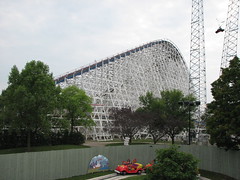
We’re poised on the edge of the first drop (147 ft, second largest drop in the park and still well within the top ten for wooden coasters) and here’s a good sight to behold: no trim brakes anywhere along the first stretch of the ride (evidently I’ve been conditioned by Mean Streak to just assume they will be a prominent feature on any coaster that predates CCI’s first work). The train falls way down, partially into a valley, the return tracks flanking either side of us and creating a cool support bridge overhead as we pull out of the first drop.
The official statistic for speed is 66 mph. Normally I take those values with a grain of salt,  at least for older coasters that probably haven’t run at their listed speed since opening season, but with no trim brakes or anything else holding us back, I must say, it felt fast. Almost dangerously fast. Despite the high speeds it wasn’t rough; those excellent Viper crews obviously have been spending a fair amount of time on the Eagle as well. There was however a strong vibration, unlike anything else I’ve ever experienced: an extremely fine-but-aggressive vibration, like we’re sitting in a vibra-massage chair set on high. It doesn’t jostle us around in our seats in any particular direction, it just rattles our nerves while our center of gravity moves smoothly forward like we’re on Raging Bull. It also rattles my nerves thinking about how ridiculously over-speed we must be going to get this sort of sensation. at least for older coasters that probably haven’t run at their listed speed since opening season, but with no trim brakes or anything else holding us back, I must say, it felt fast. Almost dangerously fast. Despite the high speeds it wasn’t rough; those excellent Viper crews obviously have been spending a fair amount of time on the Eagle as well. There was however a strong vibration, unlike anything else I’ve ever experienced: an extremely fine-but-aggressive vibration, like we’re sitting in a vibra-massage chair set on high. It doesn’t jostle us around in our seats in any particular direction, it just rattles our nerves while our center of gravity moves smoothly forward like we’re on Raging Bull. It also rattles my nerves thinking about how ridiculously over-speed we must be going to get this sort of sensation.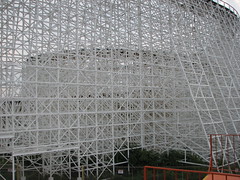
Two very low bunny hops keep this incredible pace up as we get lifted over the crest of each hill for a couple moments of floater air. “Now this is what more roller coasters should be like,” I think as we rush through the final valley before the big pull-up, the terrifying speed melting the immediate surroundings into a blur as we charge along with the utmost control, feeling as though something could go wrong at any moment even though it hasn’t. A brake run is found at the top of this hill, not a big deal because we’re so far up that the train has slowed to 10 mph anyway. While the pacing has slowed to almost nil, the downward helix works very effectively at slowly building tension, as the speed continues to increase as we make our way around it, laterals increasing, rattling getting heavier and heavier until we reach full speed in the last stretch. The slow building tension lets up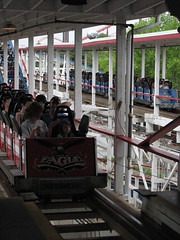 for a fast, straight stretch of track as we cross under the upper layer of the helix, and then it implodes. A dip taking us the rest of the way to ground level comes out of nowhere and hits us hard, especially riding in the back seat. Strong ejector air sustained for several long moments as the speed blasts back into the dangerous levels it was on the first leg of the journey. Some more lean, mean airtime hills follow (it differs slightly depending on which side of the track you’re on, I think the left side may have had one more hill) showing off just how much power this coaster has when it’s running at full speed. for a fast, straight stretch of track as we cross under the upper layer of the helix, and then it implodes. A dip taking us the rest of the way to ground level comes out of nowhere and hits us hard, especially riding in the back seat. Strong ejector air sustained for several long moments as the speed blasts back into the dangerous levels it was on the first leg of the journey. Some more lean, mean airtime hills follow (it differs slightly depending on which side of the track you’re on, I think the left side may have had one more hill) showing off just how much power this coaster has when it’s running at full speed.
The ride I described above could easily find its way onto my top 15 list of wooden coasters, but unfortunately those high-speed sections last too briefly, and on the return run we are halted after only two or three hills with a brake run that spits us into a pointless helix finale. Very slow by comparison to the rest of the ride, it’s also probably the roughest, and in general breaks flow and feels like it belongs to a different ride. After that distraction we’re greeted with another brake run, this one final.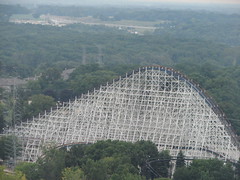
I wish I got more than just three rides on it, since I’m not sure I can count on the American Eagle running this well in the future. Especially with fast wooden coasters like this, the slightest variations such as the day’s temperature or humidity or the weight distribution of the train can start that refined vibration into a shimmy that eats away at the track and before we know it we’re on the one-way pain train to chiropractor junction. Hopefully the maintenance crew knows how to keep it in this condition since it truly was one of the better coasters at Six Flags Great America, and one of the better wooden coasters I’ve been on in general. It’s a beautiful ride as well, and if they could just figure out a better way to connect the station to the rest of the park and get some more crowd flow to that back corner of the park, I think it could be one of Six Flag’s more popular attractions. Even my mom, who generally has a low tolerance for rough or uncomfortable coasters, was first to admit before me that this was her favorite coaster in the park that day.
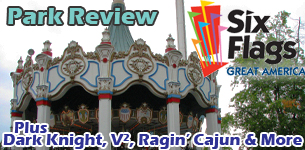 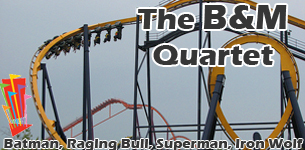
|
|
 I was once asked by a friend why Cedar Point was able to build better rides than Six Flags Great America. It caused me a moment’s pause. Great America doesn’t have much in the way of truly bad rides, and I’d say the worst roller coasters near Chicago are significantly better than the worst roller coasters near Sandusky. It’s just that the pleasures are smaller in scale, which should be no less important. Demon, Viper, American Eagle, Whizzer, and others are all coasters whose merits, though minor, are very real.
I was once asked by a friend why Cedar Point was able to build better rides than Six Flags Great America. It caused me a moment’s pause. Great America doesn’t have much in the way of truly bad rides, and I’d say the worst roller coasters near Chicago are significantly better than the worst roller coasters near Sandusky. It’s just that the pleasures are smaller in scale, which should be no less important. Demon, Viper, American Eagle, Whizzer, and others are all coasters whose merits, though minor, are very real. At that moment, however, the best defense of Great America I could think of was that they tend to be more experimentally-minded and buy more prototype technologies than their competitors or other parks in the Six Flags chain do. They have a strong relationship with Bolliger and Mabillard, I think through Bob Mampe, who worked here before going on to become one
At that moment, however, the best defense of Great America I could think of was that they tend to be more experimentally-minded and buy more prototype technologies than their competitors or other parks in the Six Flags chain do. They have a strong relationship with Bolliger and Mabillard, I think through Bob Mampe, who worked here before going on to become one of the Swiss company’s main right-hand men. As a result Great America bought the first stand up coaster from B&M, the world’s first inverted coaster, one of the first B&M speed coasters, and they were also very early adopters of both the flying coaster technology and now the wing coaster technology.
of the Swiss company’s main right-hand men. As a result Great America bought the first stand up coaster from B&M, the world’s first inverted coaster, one of the first B&M speed coasters, and they were also very early adopters of both the flying coaster technology and now the wing coaster technology. the top ten lists over the long term. The irony is, parks like Cedar Point need parks like Great America to exist. Otherwise we’d never get anything original or good. Batman: The Ride is the perfect example of this: a terrific roller coaster in its own right, Raptor expands on the qualities that made Batman good and roughly two decades later Raptor is still making the front page of the Golden Ticket Awards list while Batman (perhaps with fans scattered between its many iterants) is nowhere to be found.
the top ten lists over the long term. The irony is, parks like Cedar Point need parks like Great America to exist. Otherwise we’d never get anything original or good. Batman: The Ride is the perfect example of this: a terrific roller coaster in its own right, Raptor expands on the qualities that made Batman good and roughly two decades later Raptor is still making the front page of the Golden Ticket Awards list while Batman (perhaps with fans scattered between its many iterants) is nowhere to be found.
 That said there is more to justify the “Superman Experience” than I originally would have admitted, but what’s there still isn’t nearly enough to justify any two-hour waits. I speak from experience, as the longest I ever waited for a roller coaster was this ride back in 2005 at nearly three and a half hours (there might have been longer lines in Millennium Force’s opening year but I can’t recall the specifics). The queue is one of the most dreadful in the park, a poor combination of slow dispatch times, high popularity with the public, and a configuration that first keeps you pent up in a claustrophobic cattle pen before sun baking you in a shadeless beeline to the station with faded informational comic posters
That said there is more to justify the “Superman Experience” than I originally would have admitted, but what’s there still isn’t nearly enough to justify any two-hour waits. I speak from experience, as the longest I ever waited for a roller coaster was this ride back in 2005 at nearly three and a half hours (there might have been longer lines in Millennium Force’s opening year but I can’t recall the specifics). The queue is one of the most dreadful in the park, a poor combination of slow dispatch times, high popularity with the public, and a configuration that first keeps you pent up in a claustrophobic cattle pen before sun baking you in a shadeless beeline to the station with faded informational comic posters to keep our eyes off the many empty pairs of seats between riders that are often seen cycling overhead. Flash Pass is recommended if you’re serious about riding Superman even once on even a moderately busy day.
to keep our eyes off the many empty pairs of seats between riders that are often seen cycling overhead. Flash Pass is recommended if you’re serious about riding Superman even once on even a moderately busy day.

 so when it comes right at the beginning of the layout it makes the rest of the coaster feel boring by contrast. Airtime at the top, strong positives at the bottom, plus the rapidly changing orientation to the ground that has us in a kamikaze dive upside down. And remember these are all skewed by 90 degrees so it’s a particularly wacky brand of airtime that presses up on your chest instead of from underneath, and the force at the bottom feels like it’s going to push your stomach out of your esophagus. It’s a cool element, possibly the most impressive single maneuver inside Great America’s gates.
so when it comes right at the beginning of the layout it makes the rest of the coaster feel boring by contrast. Airtime at the top, strong positives at the bottom, plus the rapidly changing orientation to the ground that has us in a kamikaze dive upside down. And remember these are all skewed by 90 degrees so it’s a particularly wacky brand of airtime that presses up on your chest instead of from underneath, and the force at the bottom feels like it’s going to push your stomach out of your esophagus. It’s a cool element, possibly the most impressive single maneuver inside Great America’s gates. After that, layout, elements, pacing and progression all get shoved out the door in favor
After that, layout, elements, pacing and progression all get shoved out the door in favor of a somewhat idyllic series of turns that don’t accomplish anything other than give a unified sensation of flying for several seconds. From a designer’s perspective, this track is pretty simple; looking at it from the station I realized most of the curves were based on simple geometric shapes and parabolic contours, nothing more advanced or intricate, with very long transitions. This section of the ride is rather short as well,
of a somewhat idyllic series of turns that don’t accomplish anything other than give a unified sensation of flying for several seconds. From a designer’s perspective, this track is pretty simple; looking at it from the station I realized most of the curves were based on simple geometric shapes and parabolic contours, nothing more advanced or intricate, with very long transitions. This section of the ride is rather short as well, only about 22 seconds before the free-flight
only about 22 seconds before the free-flight is over and we’re wrapping it up with the final inline roll into the brakes.
is over and we’re wrapping it up with the final inline roll into the brakes.
 The coaster itself is pretty decent, particularly enhanced
The coaster itself is pretty decent, particularly enhanced at night when the line tends to be its shortest. You do have to be of a certain height to enjoy these Arrow looping coasters, as too short can mean the horsecollar restraints connect with your earlobes, and too tall means they fit uncomfortably tight on top of your shoulders. If you’re in the intended height range then the first drop and two loops can be a fun, intense and dizzying affair. I’m curious what it was like as the Turn of the Century and had two camelback hills where the loops are today; they looked like more extreme versions of Cedar Point’s Corkscrew’s single air hill and that one is quite intense by itself.
at night when the line tends to be its shortest. You do have to be of a certain height to enjoy these Arrow looping coasters, as too short can mean the horsecollar restraints connect with your earlobes, and too tall means they fit uncomfortably tight on top of your shoulders. If you’re in the intended height range then the first drop and two loops can be a fun, intense and dizzying affair. I’m curious what it was like as the Turn of the Century and had two camelback hills where the loops are today; they looked like more extreme versions of Cedar Point’s Corkscrew’s single air hill and that one is quite intense by itself. Things like the long straightaway in the special effects tunnel or diving through the mouth of a rock face cave help make the coaster an exciting one, campy though these touches are. The second half after the tunnel doesn’t have quite as much going for it as the first; the turnaround takes a while to get through and then the corkscrews over the railroad tracks and final helix are both a bit slower paced and a bit rougher (the transition from the drop into the first corkscrew in particular has a bad kink in it you’ll want to brace for). But it helps round out the layout to feel more complete than some of the other early small scale Arrow multiloopers that barge through the course in less than 45 seconds. Honestly I don’t miss the much larger Shockwave at all since Great America
Things like the long straightaway in the special effects tunnel or diving through the mouth of a rock face cave help make the coaster an exciting one, campy though these touches are. The second half after the tunnel doesn’t have quite as much going for it as the first; the turnaround takes a while to get through and then the corkscrews over the railroad tracks and final helix are both a bit slower paced and a bit rougher (the transition from the drop into the first corkscrew in particular has a bad kink in it you’ll want to brace for). But it helps round out the layout to feel more complete than some of the other early small scale Arrow multiloopers that barge through the course in less than 45 seconds. Honestly I don’t miss the much larger Shockwave at all since Great America still has the Demon, whose mixture of low-key thrills with a larger-than-life persona and 1980’s cheese fest, make it one of the most purely fun coasters in Six Flags Great America.
still has the Demon, whose mixture of low-key thrills with a larger-than-life persona and 1980’s cheese fest, make it one of the most purely fun coasters in Six Flags Great America.
 I think it was just that the coaster lacked much bite. Many of the bookending fan turns were a bit of a snooze, the first one with very gentle lead-ins/outs from the hill crests, and while the others have some lateral force to them the transitions feel similarly controlled. There was none of the sharp snaps around corners and into drops that I enjoyed on the Georgia Cyclone. Things are better when moving along a mostly straight path over camelbacks or bunny hops, but again in all seats they lacked any sort of aggressiveness, instead opting for smooth, sustained floater air. That’s alright in most cases, but not for a ride based on the Cyclone where I expect more out-of-control intensity. Regardless, this isn’t the ideal layout for that type of airtime since only one or two hills are achieved before the pace has to halt for another fan turn that accomplishes little besides
I think it was just that the coaster lacked much bite. Many of the bookending fan turns were a bit of a snooze, the first one with very gentle lead-ins/outs from the hill crests, and while the others have some lateral force to them the transitions feel similarly controlled. There was none of the sharp snaps around corners and into drops that I enjoyed on the Georgia Cyclone. Things are better when moving along a mostly straight path over camelbacks or bunny hops, but again in all seats they lacked any sort of aggressiveness, instead opting for smooth, sustained floater air. That’s alright in most cases, but not for a ride based on the Cyclone where I expect more out-of-control intensity. Regardless, this isn’t the ideal layout for that type of airtime since only one or two hills are achieved before the pace has to halt for another fan turn that accomplishes little besides turning the train around again. Probably the most effective moment was the double dip off the second turn and the sharp, straight camelback hill buried in the lift super structure that followed. Intense, yes. Aggressive, not quite; the transitions were still feather-light and lacked the snap I’d expect from a true wooden twister. It’s not enough to just be held out of my seat, I want to be jolted out of it. Maybe it was just a case of having the wrong expectations, but I personally would take the other, edgier Cyclone counterparts over this one any day of the week. Viper is the caffeine-free substitute product for people who find the original too strong.
turning the train around again. Probably the most effective moment was the double dip off the second turn and the sharp, straight camelback hill buried in the lift super structure that followed. Intense, yes. Aggressive, not quite; the transitions were still feather-light and lacked the snap I’d expect from a true wooden twister. It’s not enough to just be held out of my seat, I want to be jolted out of it. Maybe it was just a case of having the wrong expectations, but I personally would take the other, edgier Cyclone counterparts over this one any day of the week. Viper is the caffeine-free substitute product for people who find the original too strong. gave much thought to. Which genius was it that thought a gigantic helix in the middle of a twin-tracked coaster would be a good element to ensure evenly timed races? The plus-plus-sized heights and speeds only meant that a): the fast parts would be all the more rough and unbearable, and b): they would quickly be braked, turning it into one of those overscaled lame duck monstrosities. Being one of only two coasters in the park without Flash Pass entry is also not a good omen; the station is located behind the railroad tracks leading to an awkward, half-mile queue over and around obstacles that would be nearly impossible to integrate a Flash Pass merge point with, not that it matters since the dual dispatches and lower popularity mean it usually has some of the shortest lines in the park anyway.
gave much thought to. Which genius was it that thought a gigantic helix in the middle of a twin-tracked coaster would be a good element to ensure evenly timed races? The plus-plus-sized heights and speeds only meant that a): the fast parts would be all the more rough and unbearable, and b): they would quickly be braked, turning it into one of those overscaled lame duck monstrosities. Being one of only two coasters in the park without Flash Pass entry is also not a good omen; the station is located behind the railroad tracks leading to an awkward, half-mile queue over and around obstacles that would be nearly impossible to integrate a Flash Pass merge point with, not that it matters since the dual dispatches and lower popularity mean it usually has some of the shortest lines in the park anyway. largest drop in the park and still well within the top ten for wooden coasters) and here’s a good sight to behold: no trim brakes anywhere along the first stretch of the ride! (Evidently I’ve been conditioned by Mean Streak to just assume they will be a prominent feature on any coaster that predates CCI’s first work.) The train falls way down, partially into a valley, the return tracks flanking either side of us and creating a cool support bridge overhead as we pull out of the first drop.
largest drop in the park and still well within the top ten for wooden coasters) and here’s a good sight to behold: no trim brakes anywhere along the first stretch of the ride! (Evidently I’ve been conditioned by Mean Streak to just assume they will be a prominent feature on any coaster that predates CCI’s first work.) The train falls way down, partially into a valley, the return tracks flanking either side of us and creating a cool support bridge overhead as we pull out of the first drop. it felt fast. Almost dangerously fast. Despite the high speeds it wasn’t rough; those excellent Viper crews obviously have been spending a fair amount of time on the Eagle as well. However, there was a strong vibration, unlike anything else I’ve ever experienced: an extremely fine but aggressive vibration, like we’re sitting in a vibra-massage chair set on high. It doesn’t jostle us around, it just rattles our nerves while our center of gravity moves smoothly forward like we’re on Raging Bull. It also rattles my nerves thinking about how ridiculously fast we must be going to get this sort of sensation.
it felt fast. Almost dangerously fast. Despite the high speeds it wasn’t rough; those excellent Viper crews obviously have been spending a fair amount of time on the Eagle as well. However, there was a strong vibration, unlike anything else I’ve ever experienced: an extremely fine but aggressive vibration, like we’re sitting in a vibra-massage chair set on high. It doesn’t jostle us around, it just rattles our nerves while our center of gravity moves smoothly forward like we’re on Raging Bull. It also rattles my nerves thinking about how ridiculously fast we must be going to get this sort of sensation. I think as we rush through the final valley before the big pull-up, the terrifying speed melting the immediate surroundings into a blur as we charge along with the utmost control, feeling as though something could go wrong at any moment even though it hasn’t. A brake run is found at the top of this hill, not a big deal because we’re so far up that the train has slowed to 10 mph anyway. While the pacing has slowed to almost nil, the downward helix works very effectively at slowly building tension, as the speed continues to increase as we make our way around it, laterals increasing, vibrations getting stronger and stronger until we reach full speed in the last stretch. The slow building tension lets up for a fast, straight stretch of track as we cross under the upper layer of the helix, and then it implodes. A dip taking us the rest of the way to ground level comes
I think as we rush through the final valley before the big pull-up, the terrifying speed melting the immediate surroundings into a blur as we charge along with the utmost control, feeling as though something could go wrong at any moment even though it hasn’t. A brake run is found at the top of this hill, not a big deal because we’re so far up that the train has slowed to 10 mph anyway. While the pacing has slowed to almost nil, the downward helix works very effectively at slowly building tension, as the speed continues to increase as we make our way around it, laterals increasing, vibrations getting stronger and stronger until we reach full speed in the last stretch. The slow building tension lets up for a fast, straight stretch of track as we cross under the upper layer of the helix, and then it implodes. A dip taking us the rest of the way to ground level comes out of nowhere and hits us hard, especially riding in the back seat. Strong ejector air is sustained for a moment as the speed blasts back into the dangerous levels it was on the first leg of the journey. Some more lean, mean airtime hills follow showing off just how
out of nowhere and hits us hard, especially riding in the back seat. Strong ejector air is sustained for a moment as the speed blasts back into the dangerous levels it was on the first leg of the journey. Some more lean, mean airtime hills follow showing off just how much power this coaster has when it’s running at full speed. It differs slightly depending on which side you’re on; the red side (left track going up the lift) is more intense with an extra airtime hill on the way back.
much power this coaster has when it’s running at full speed. It differs slightly depending on which side you’re on; the red side (left track going up the lift) is more intense with an extra airtime hill on the way back.
 It starts with the trains, which are designed placing riders inline, allowing two people to share in the excitement of the ride together if they wish, and for single riders there is plenty of legroom and the restraints (a loose seatbelt, which there’s always
It starts with the trains, which are designed placing riders inline, allowing two people to share in the excitement of the ride together if they wish, and for single riders there is plenty of legroom and the restraints (a loose seatbelt, which there’s always someone who can’t figure it out and holds everyone else up) are as non-restrictive as they come just short of no restraints at all. The low slung sides also allow for one plenty of visual freedom, as well as increasing the sense of exposure to the surroundings as you feel as though you could easily reach out and grab leaves off the trees if you really wanted to. The spiral lift is a relative oddity in this day and age. The motors that power it uphill are located inside the trains
someone who can’t figure it out and holds everyone else up) are as non-restrictive as they come just short of no restraints at all. The low slung sides also allow for one plenty of visual freedom, as well as increasing the sense of exposure to the surroundings as you feel as though you could easily reach out and grab leaves off the trees if you really wanted to. The spiral lift is a relative oddity in this day and age. The motors that power it uphill are located inside the trains under your seat, although I’m not sure if they’re powered from an electrical strip along the lift or are completely self-contained. Because the lift wraps around three and a half times we have plenty of time to think about the ride ahead before we get to the top.
under your seat, although I’m not sure if they’re powered from an electrical strip along the lift or are completely self-contained. Because the lift wraps around three and a half times we have plenty of time to think about the ride ahead before we get to the top.
 you encourage young enthusiasts to get back in line a second time.
you encourage young enthusiasts to get back in line a second time. even after multiple laps, it’s where I always tend to find myself heading once the sun starts to dip below the horizon during a day at Great America. The very thought that it was nearly removed for Superman back in 2002 is quite upsetting, but thankfully I was far from alone in these sentiments. Should it ever need to be retired for legitimate reasons, hopefully Six Flags can contract Mack or Gerstlauer to carefully recreate the entire layout with as little disruption to the station and landscape as possible. If they need to introduce new seating configurations to increase capacity I can accept that, and if they want to add a little more spice to the second half of the layout I’d be more than happy. They can scrap X-Flight, they can level Viper, Raging Bull can be relocated to Mars for all I care. Just leave the Whizzer for future generations, and I’ll always have a reason to come back.
even after multiple laps, it’s where I always tend to find myself heading once the sun starts to dip below the horizon during a day at Great America. The very thought that it was nearly removed for Superman back in 2002 is quite upsetting, but thankfully I was far from alone in these sentiments. Should it ever need to be retired for legitimate reasons, hopefully Six Flags can contract Mack or Gerstlauer to carefully recreate the entire layout with as little disruption to the station and landscape as possible. If they need to introduce new seating configurations to increase capacity I can accept that, and if they want to add a little more spice to the second half of the layout I’d be more than happy. They can scrap X-Flight, they can level Viper, Raging Bull can be relocated to Mars for all I care. Just leave the Whizzer for future generations, and I’ll always have a reason to come back.































































Comments